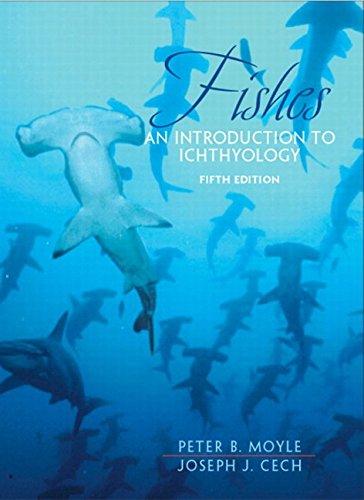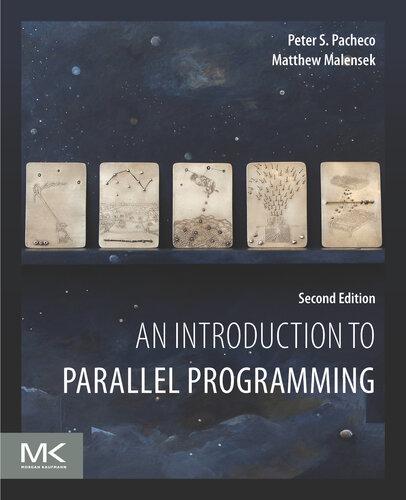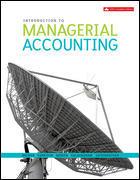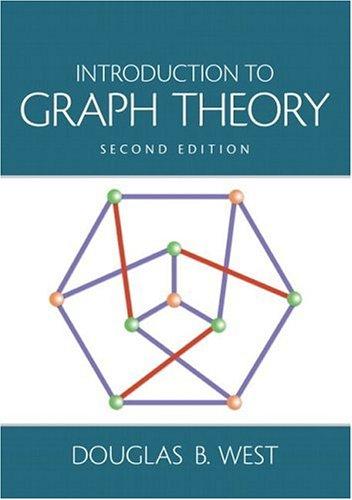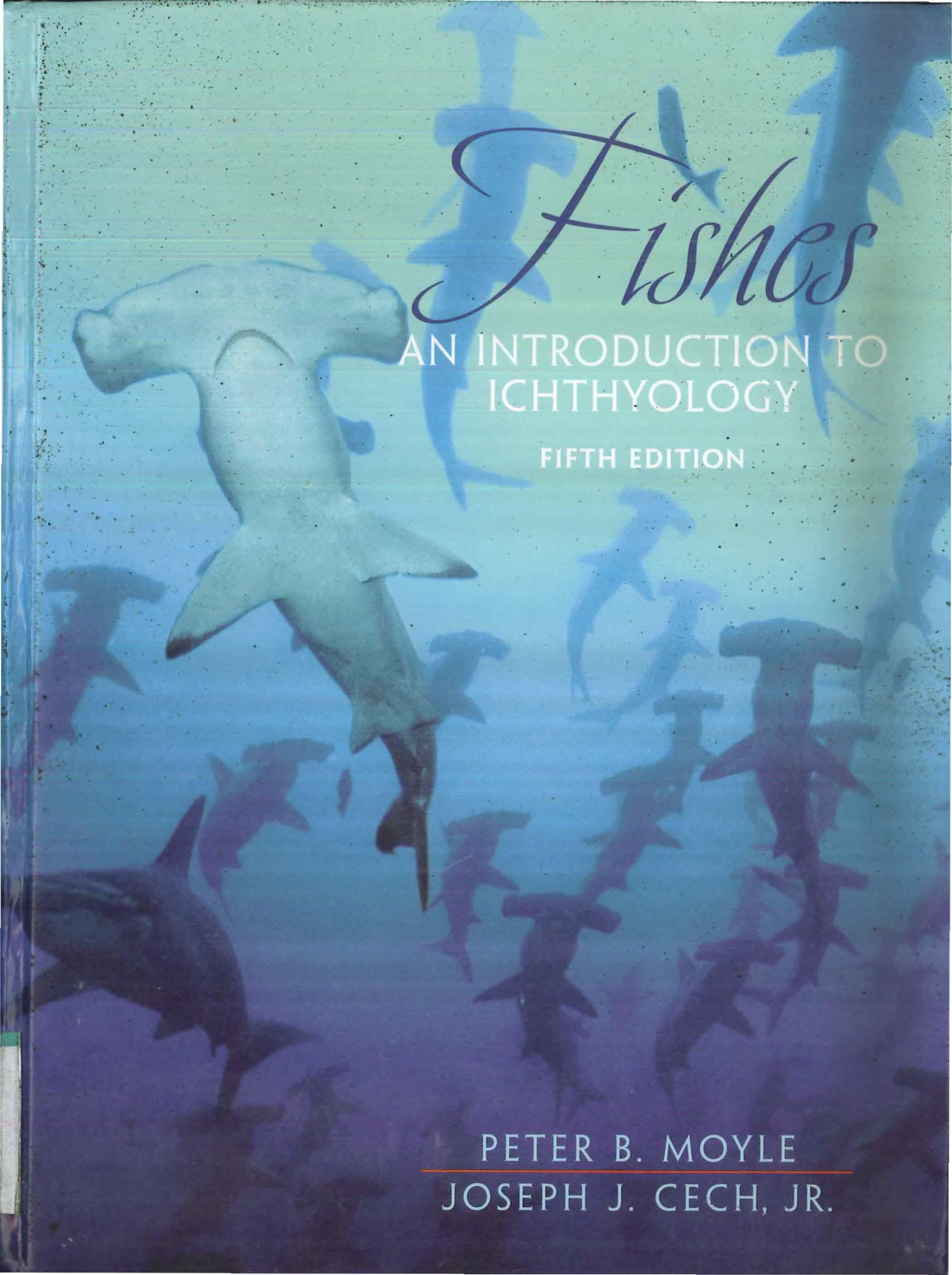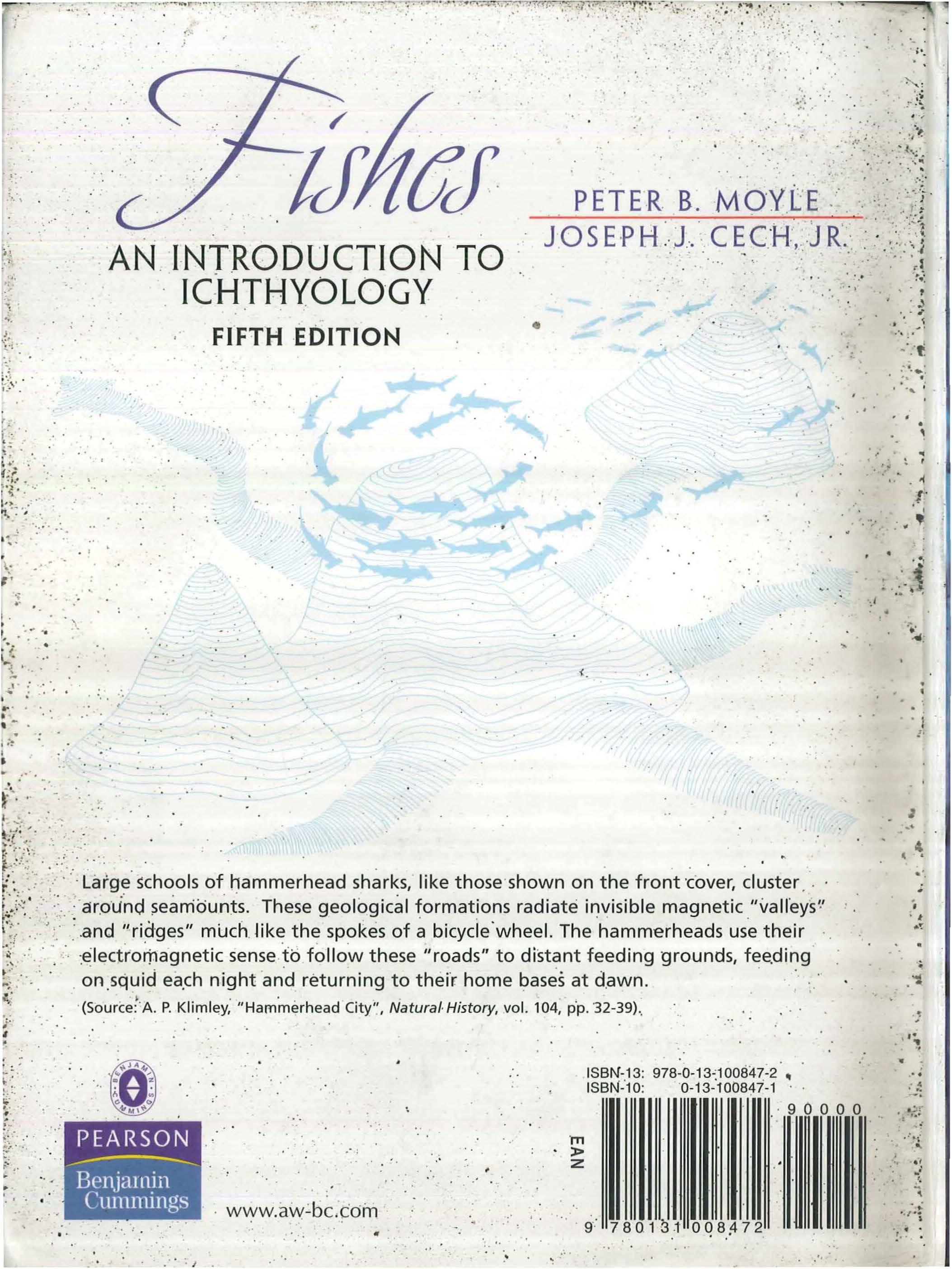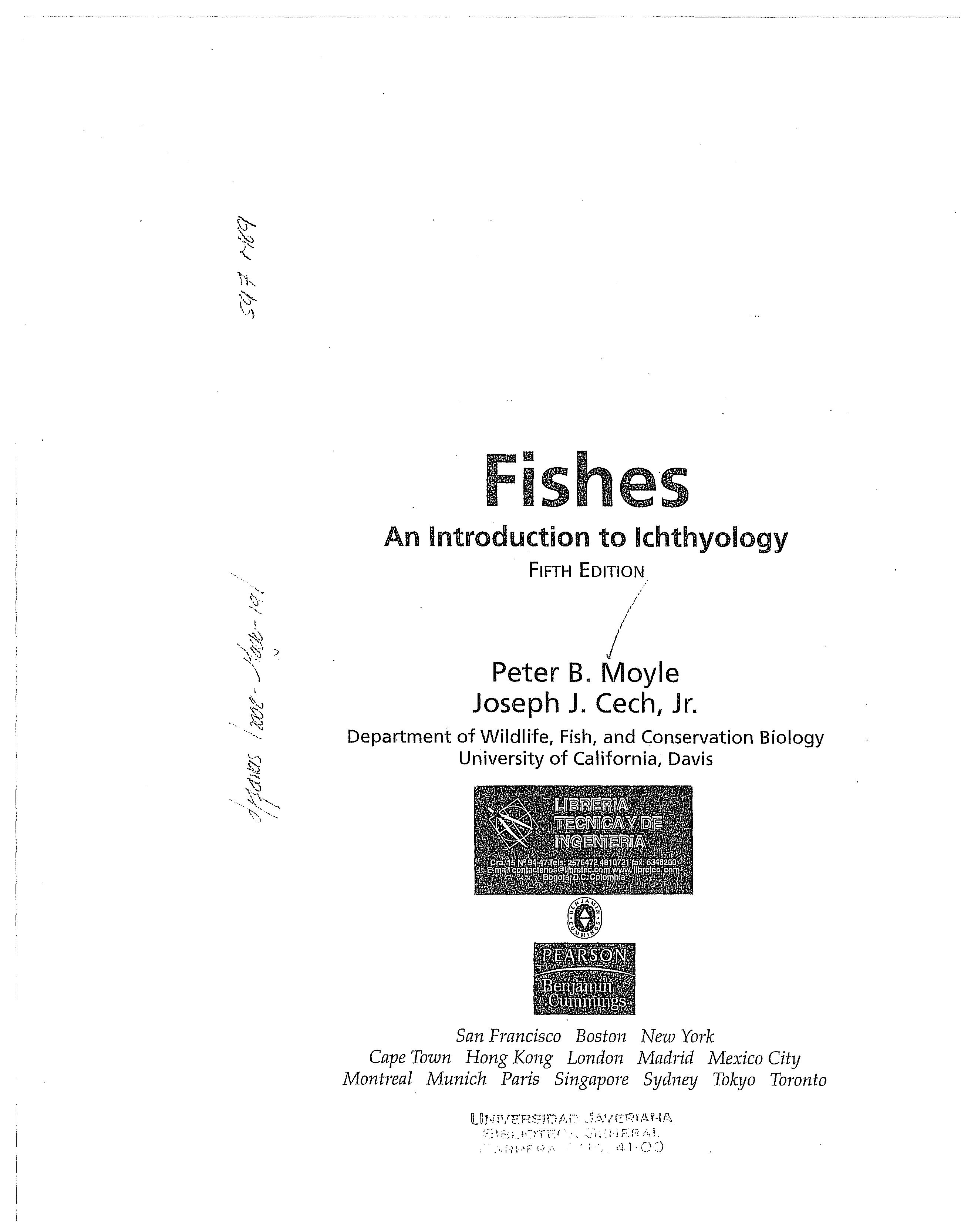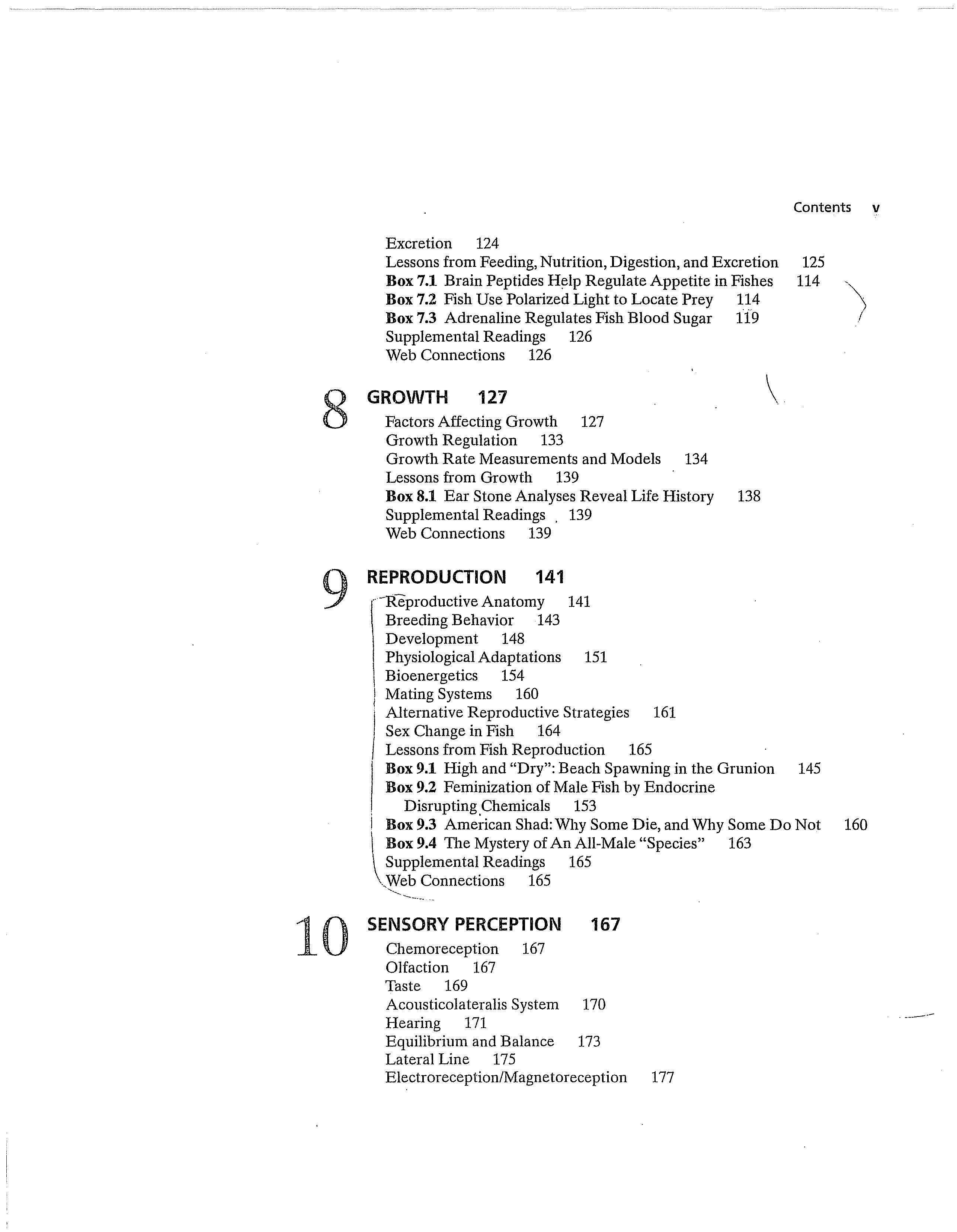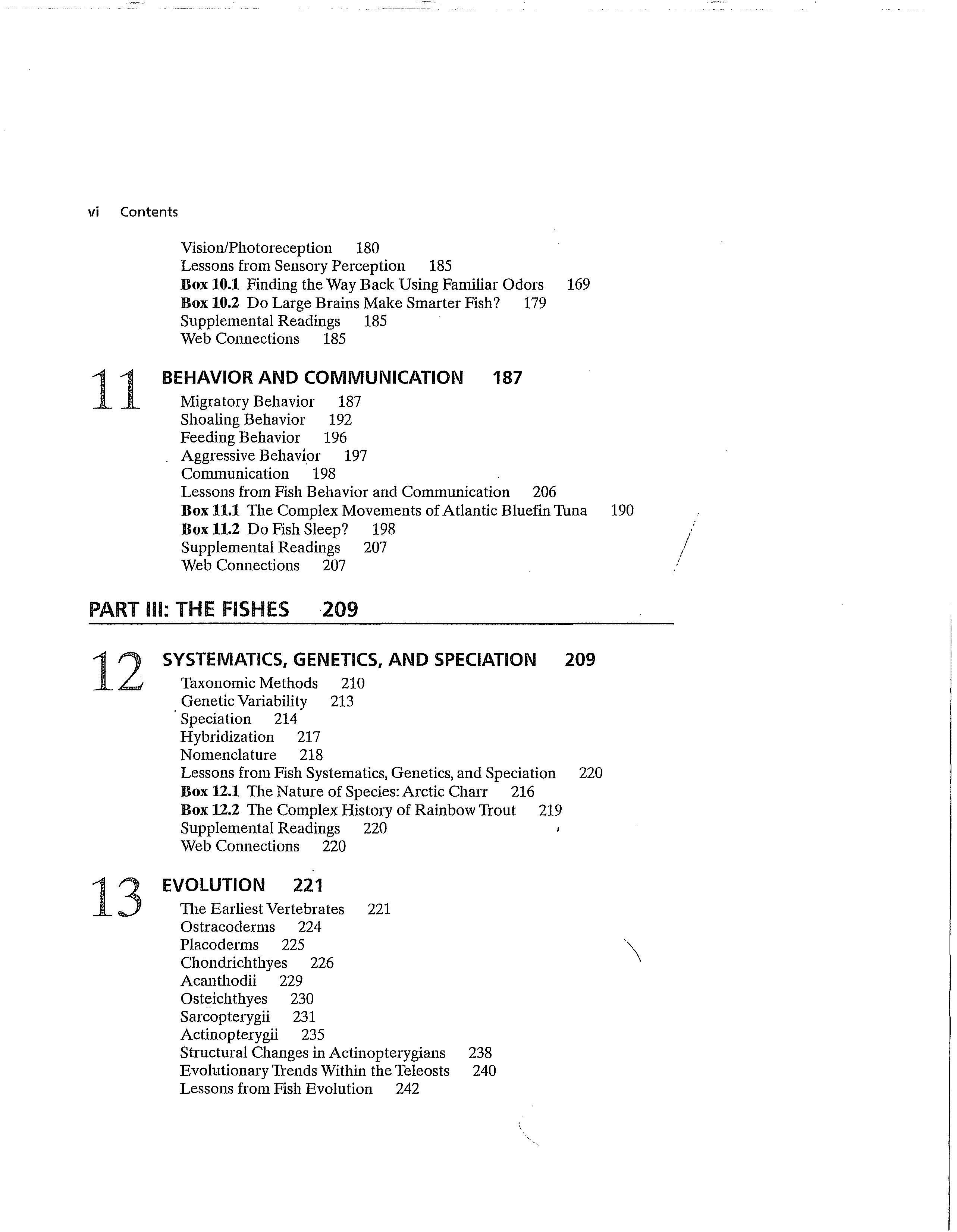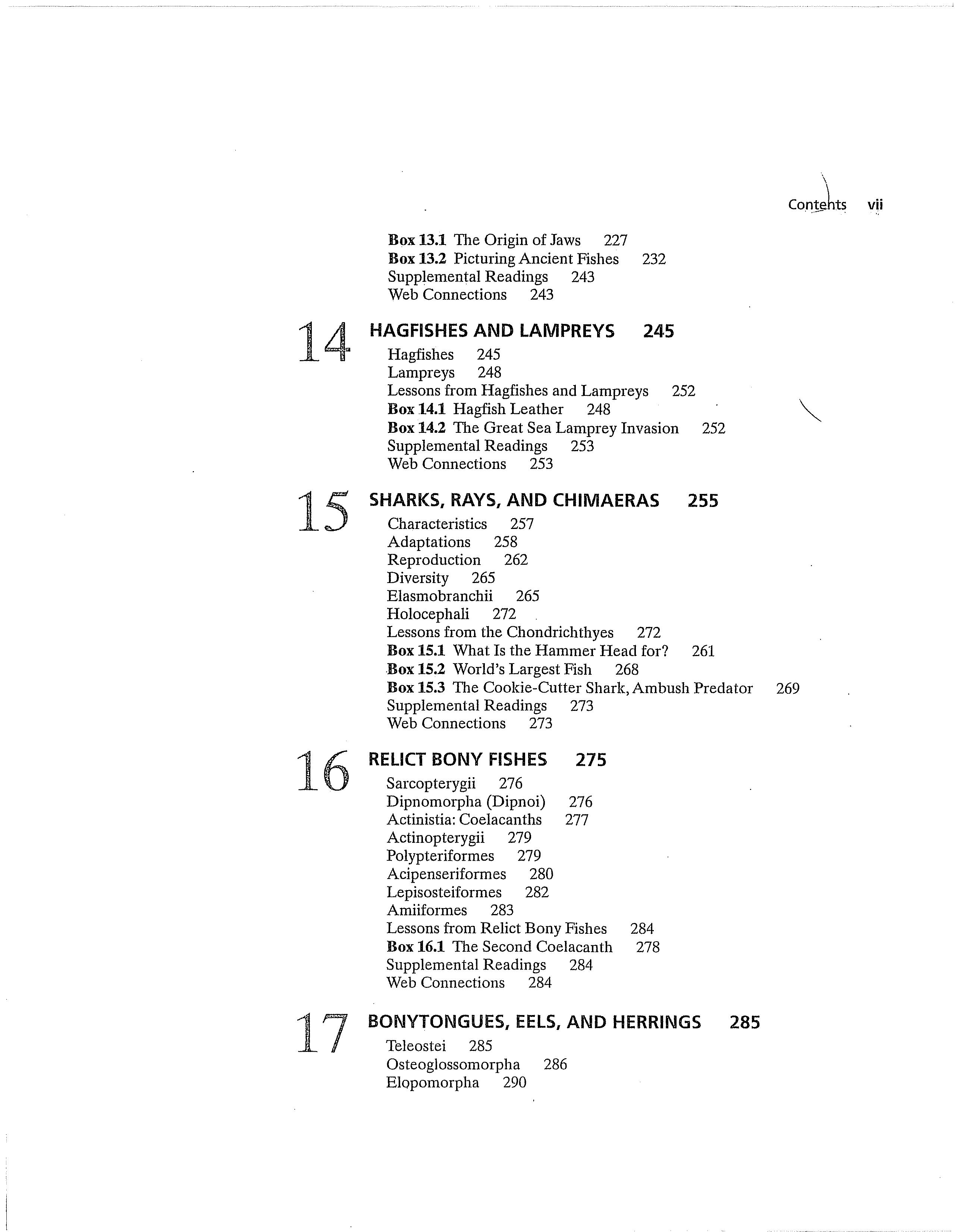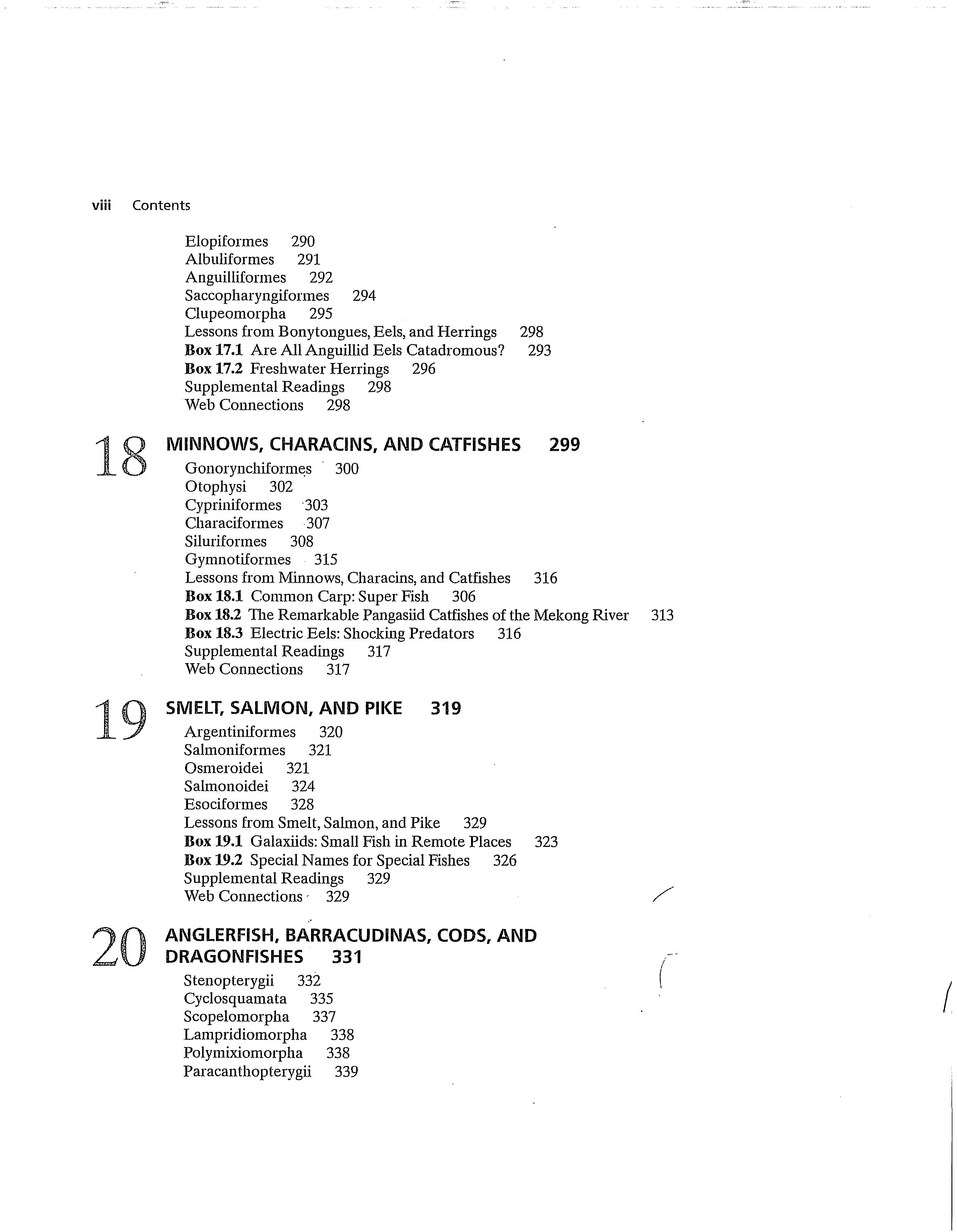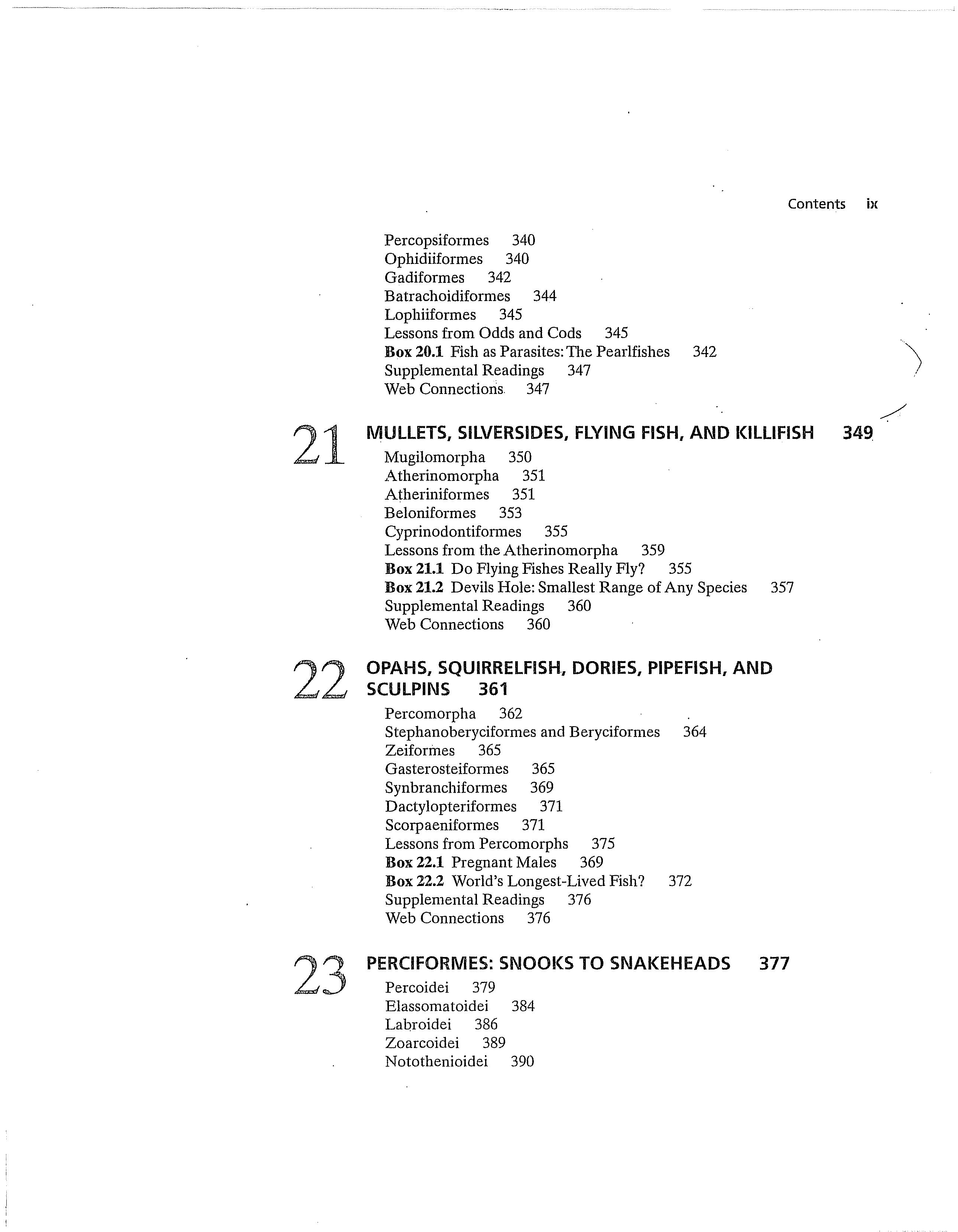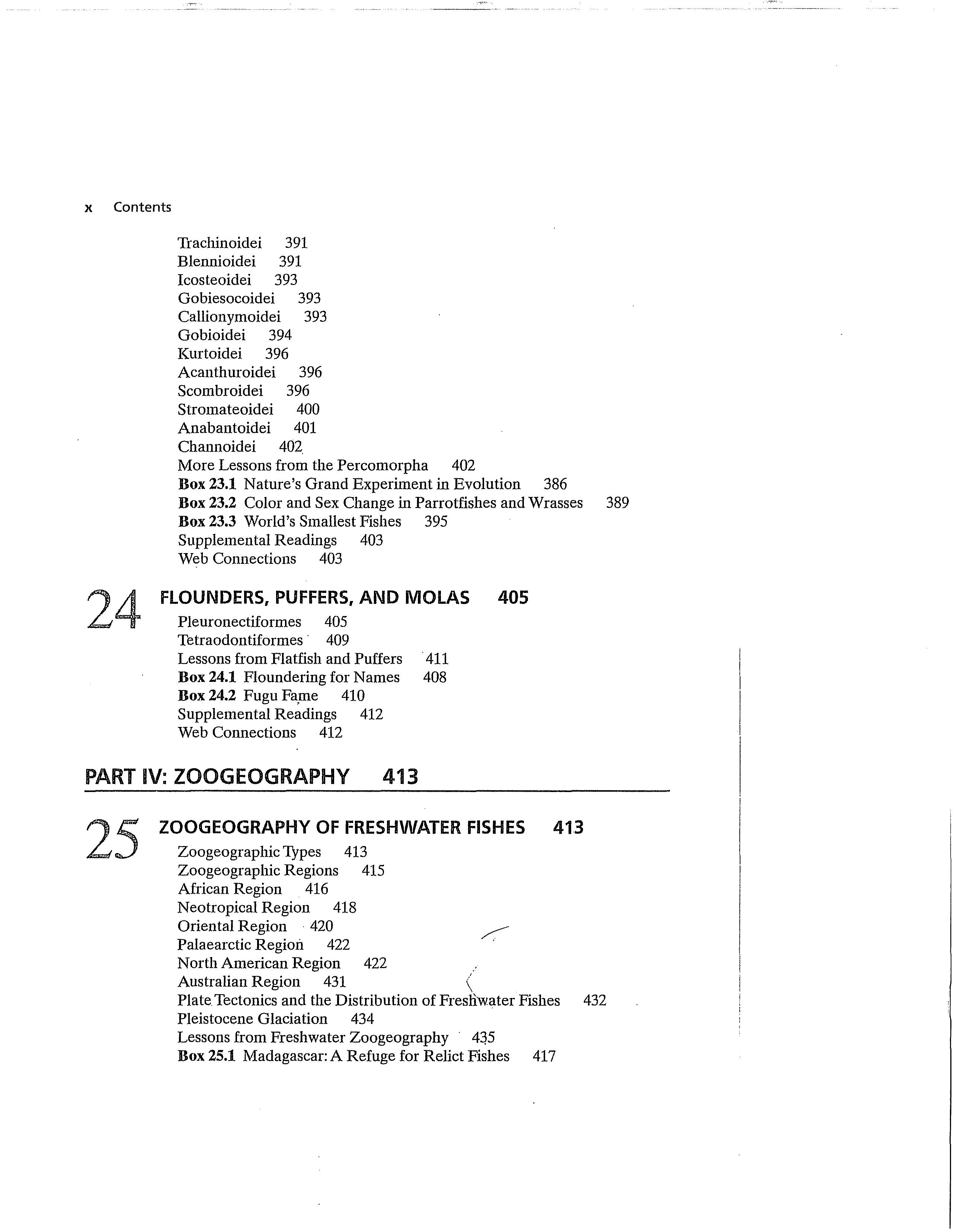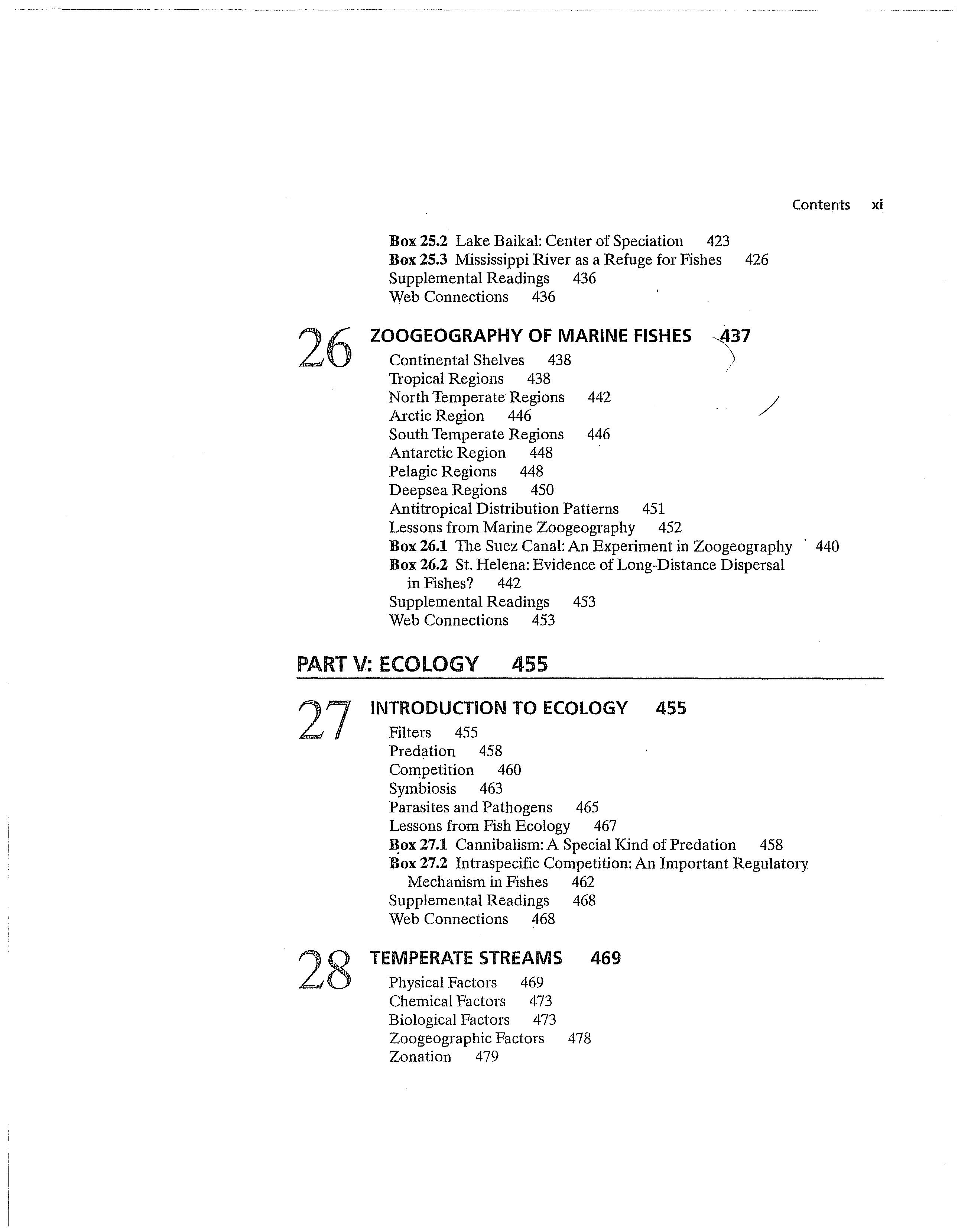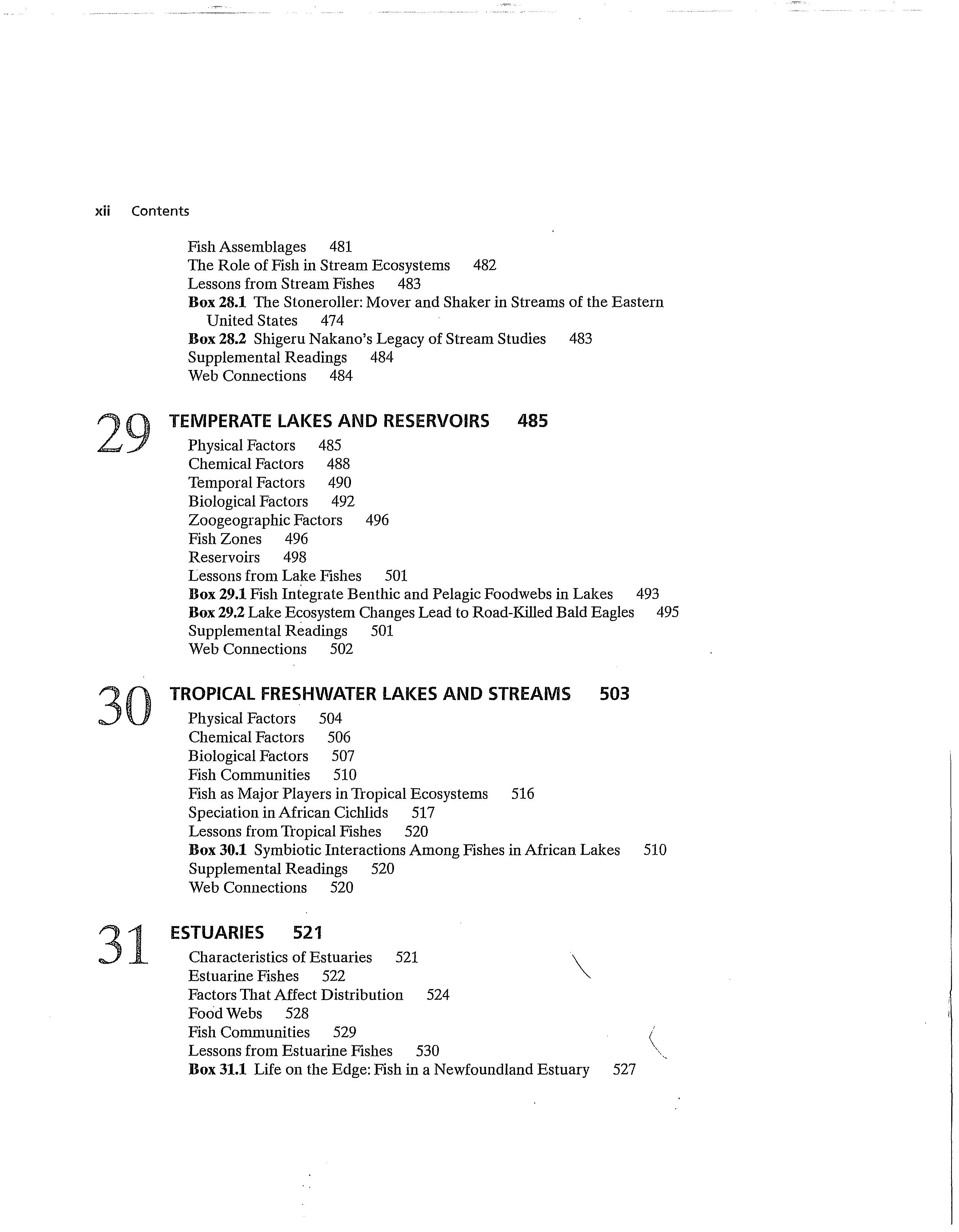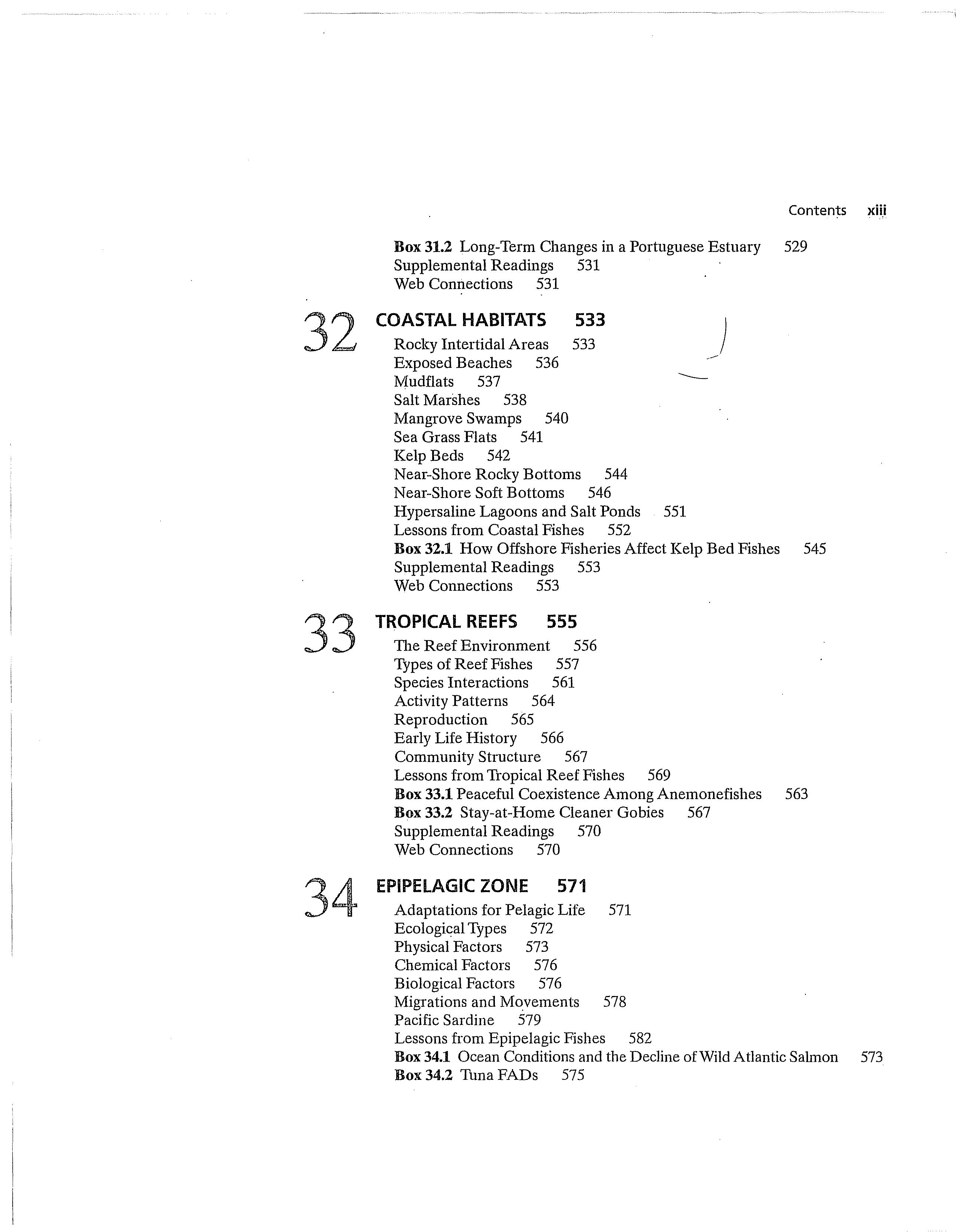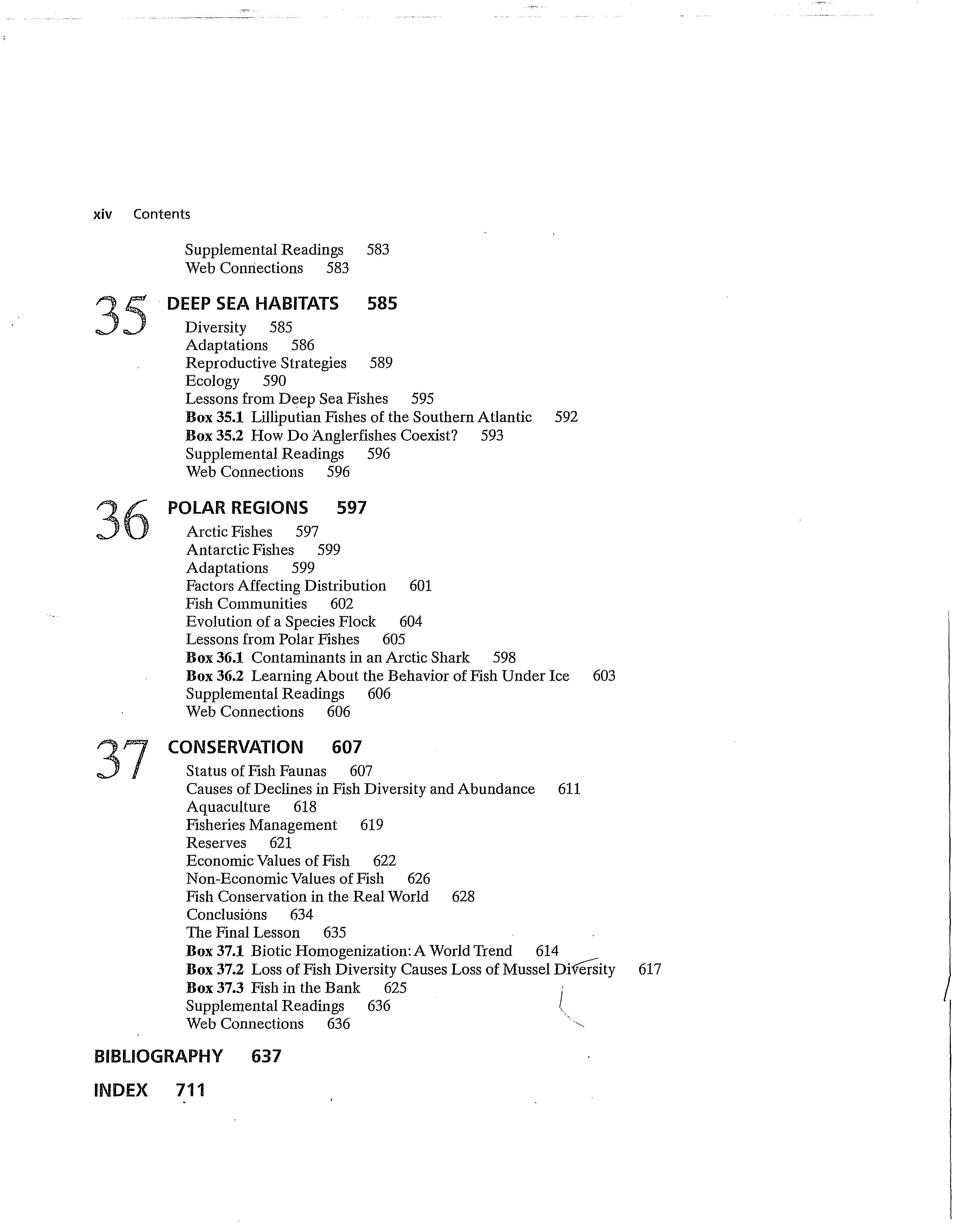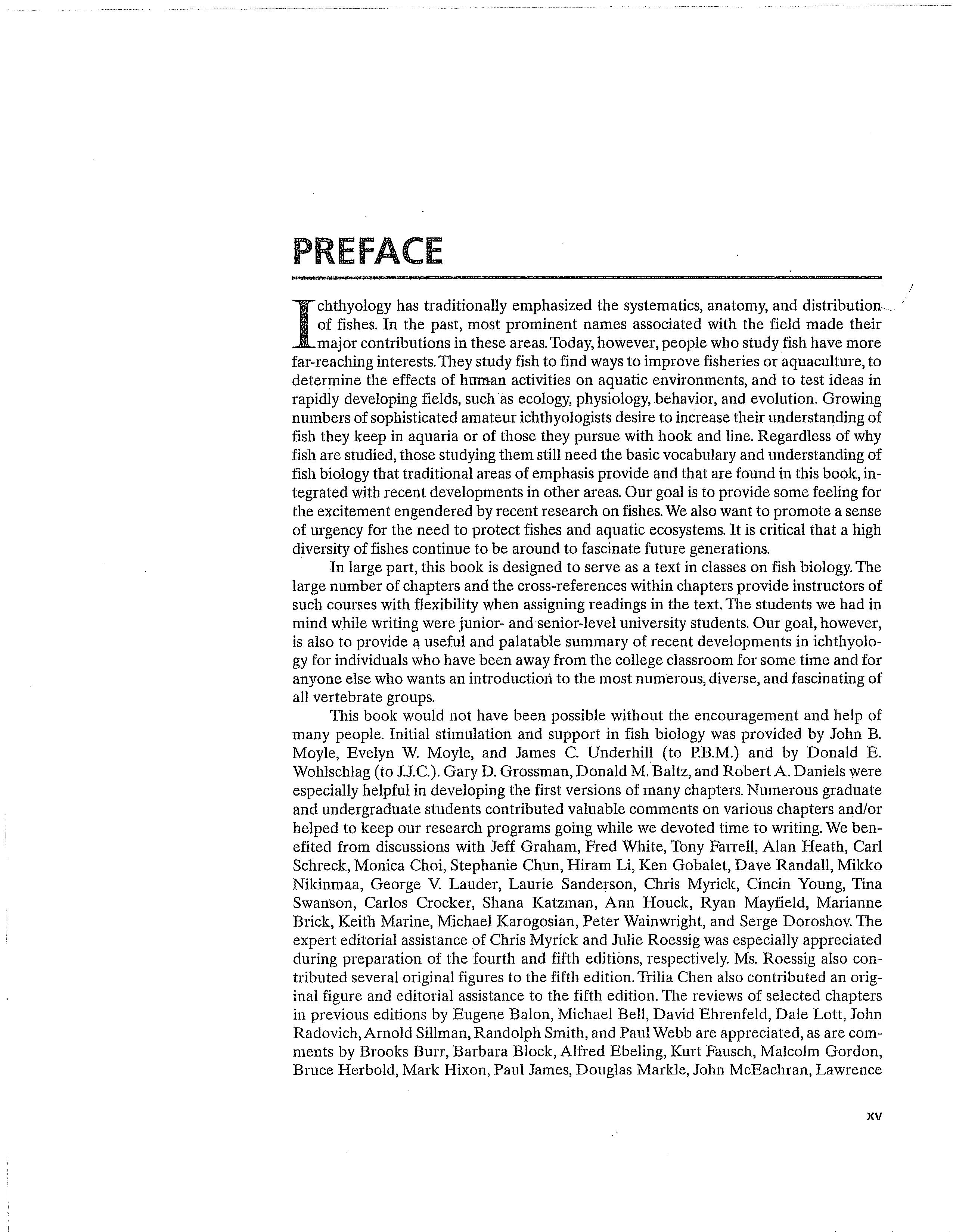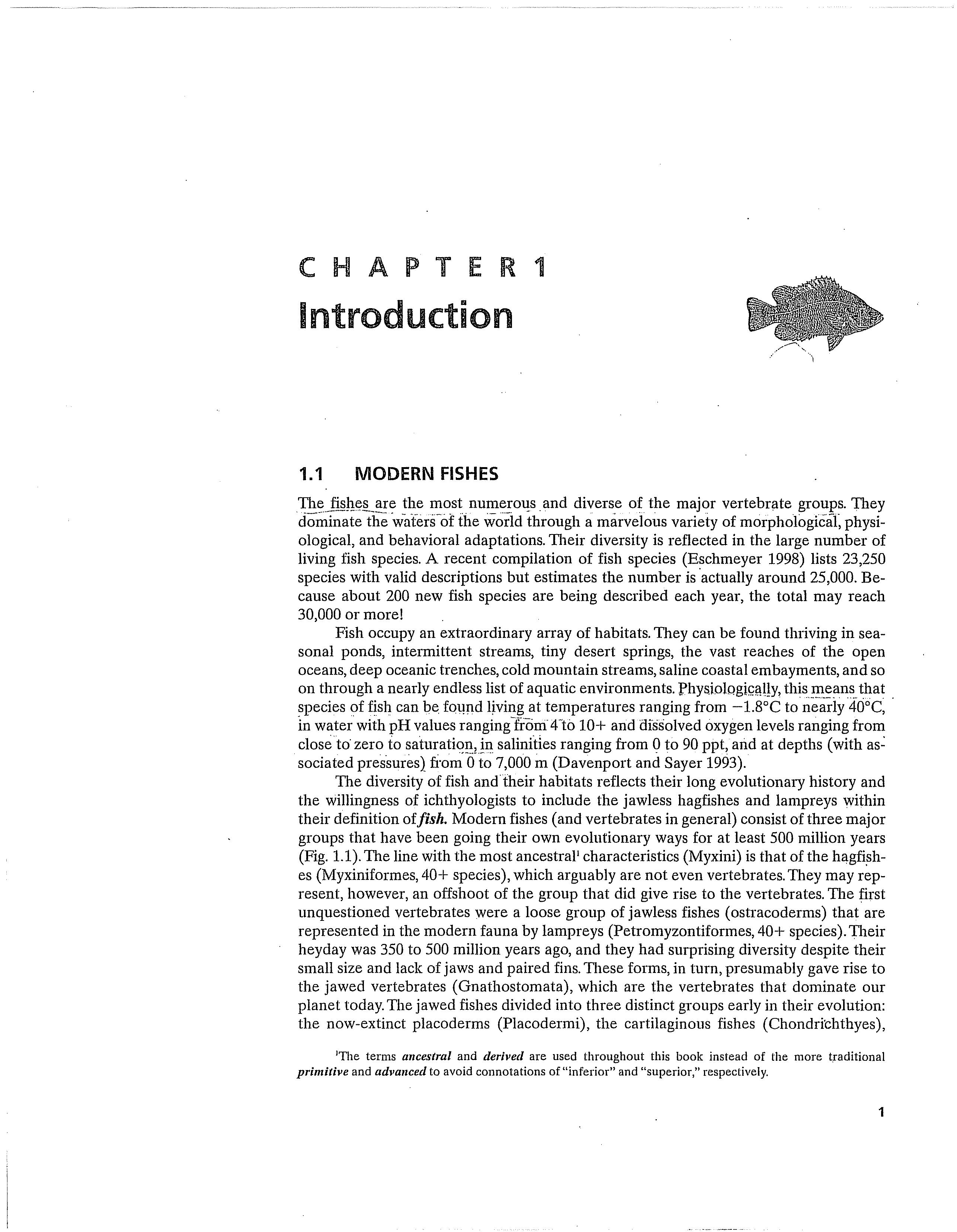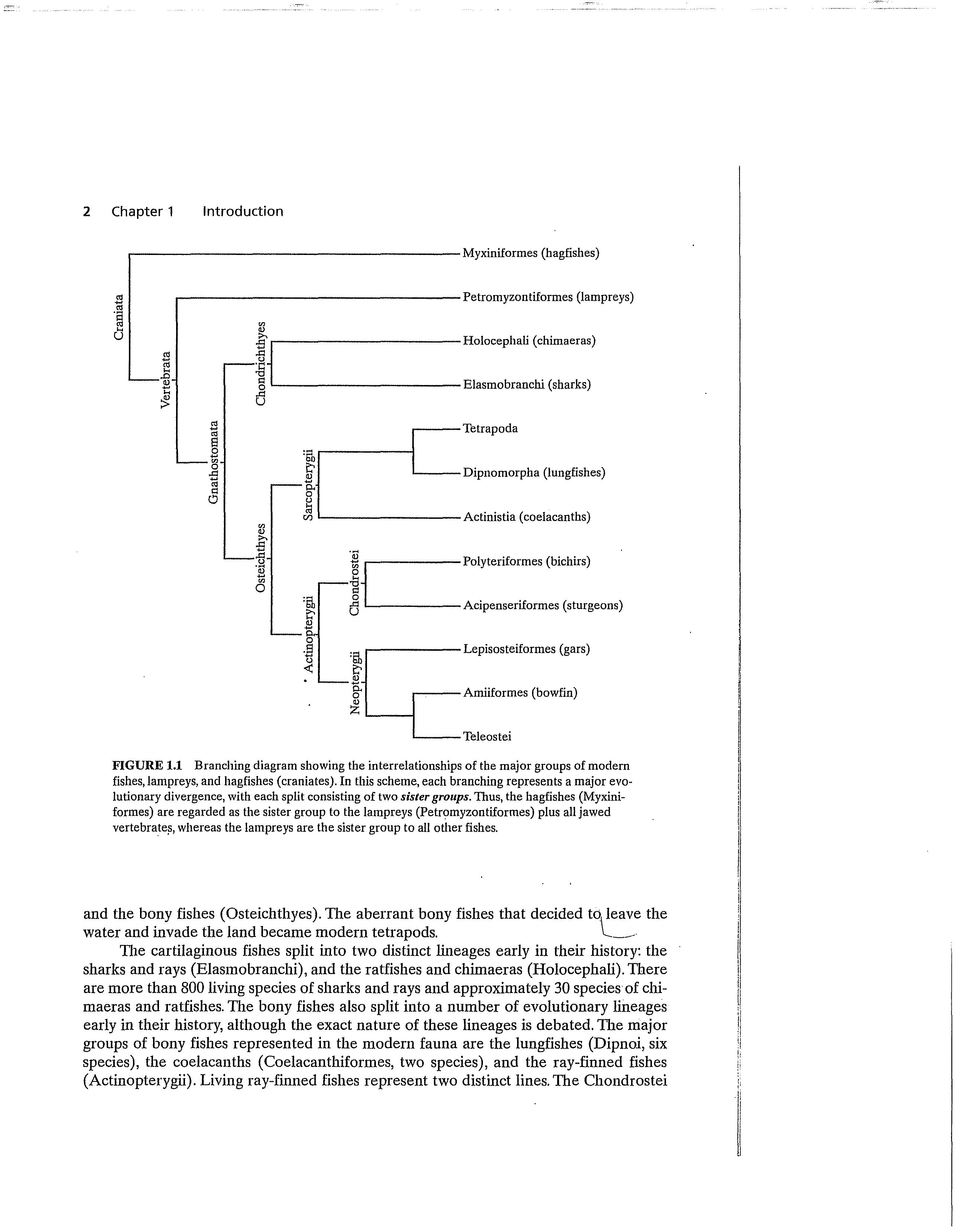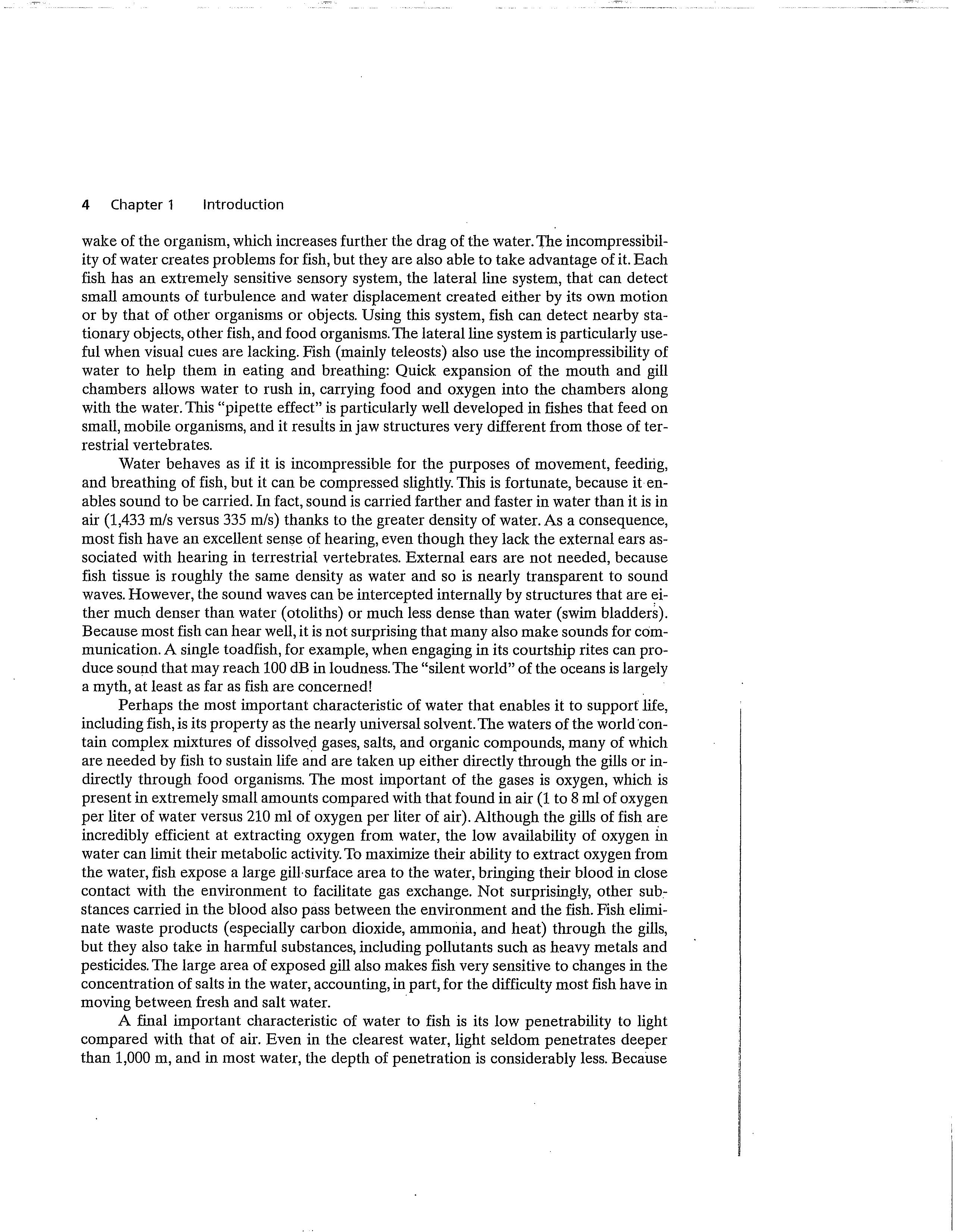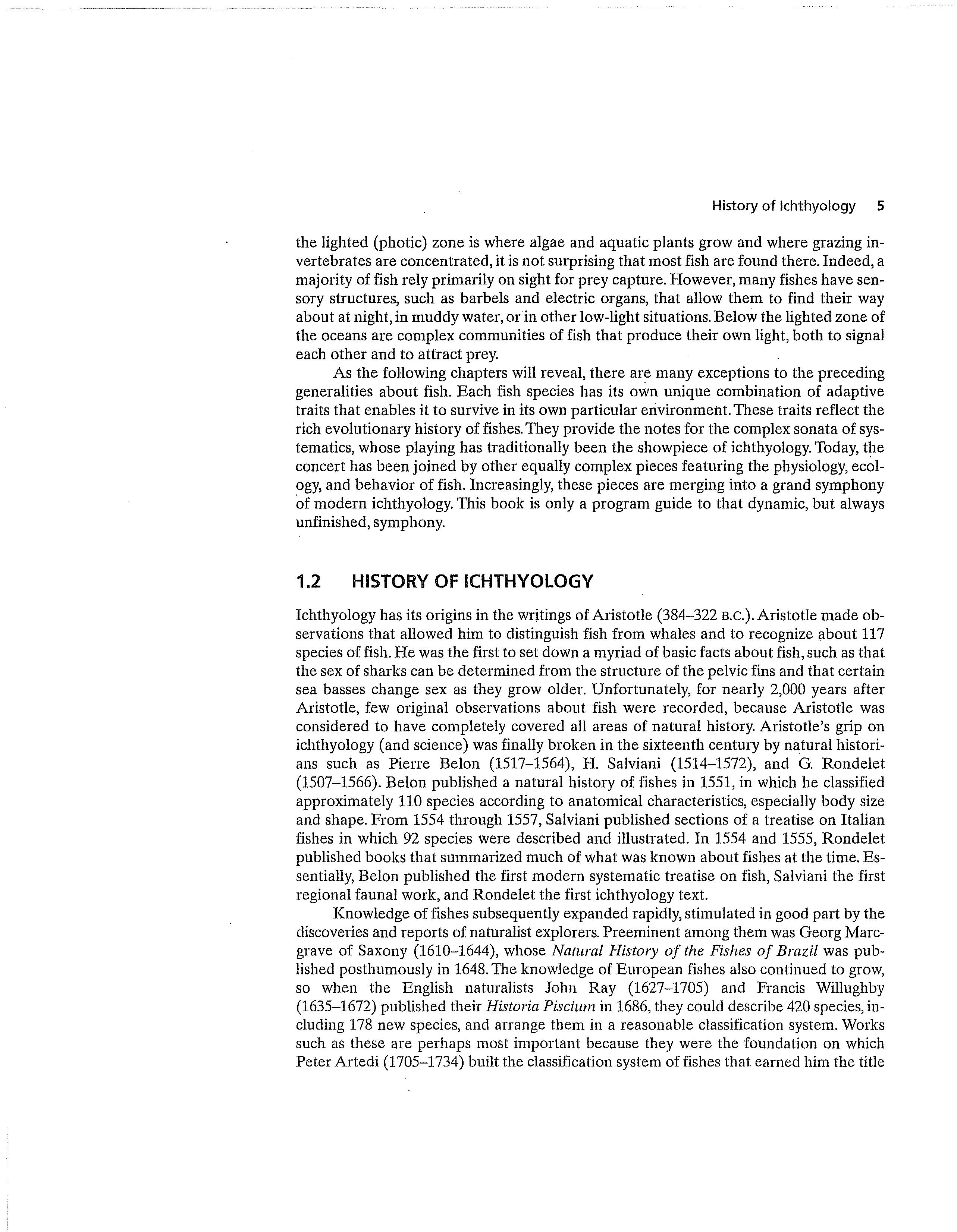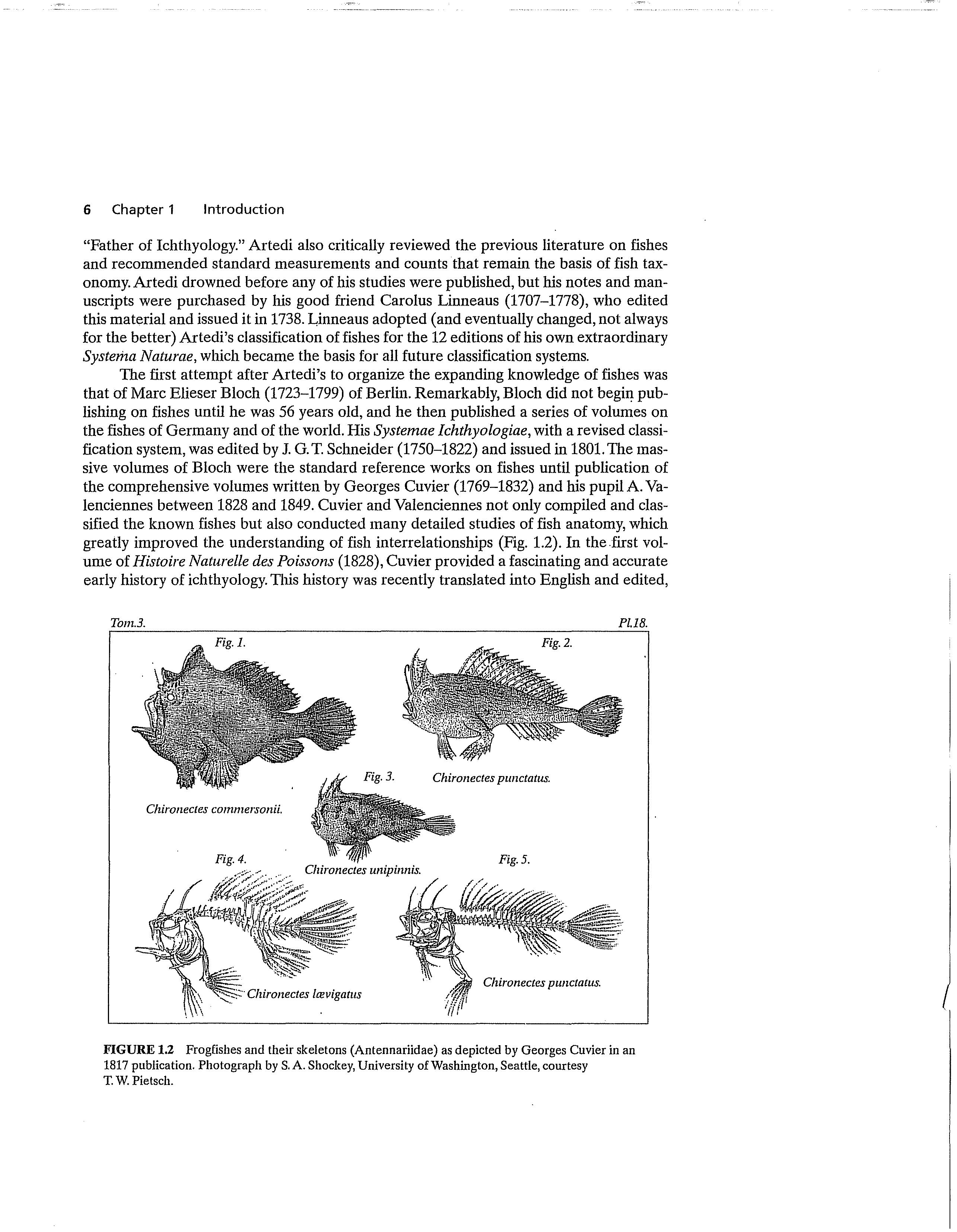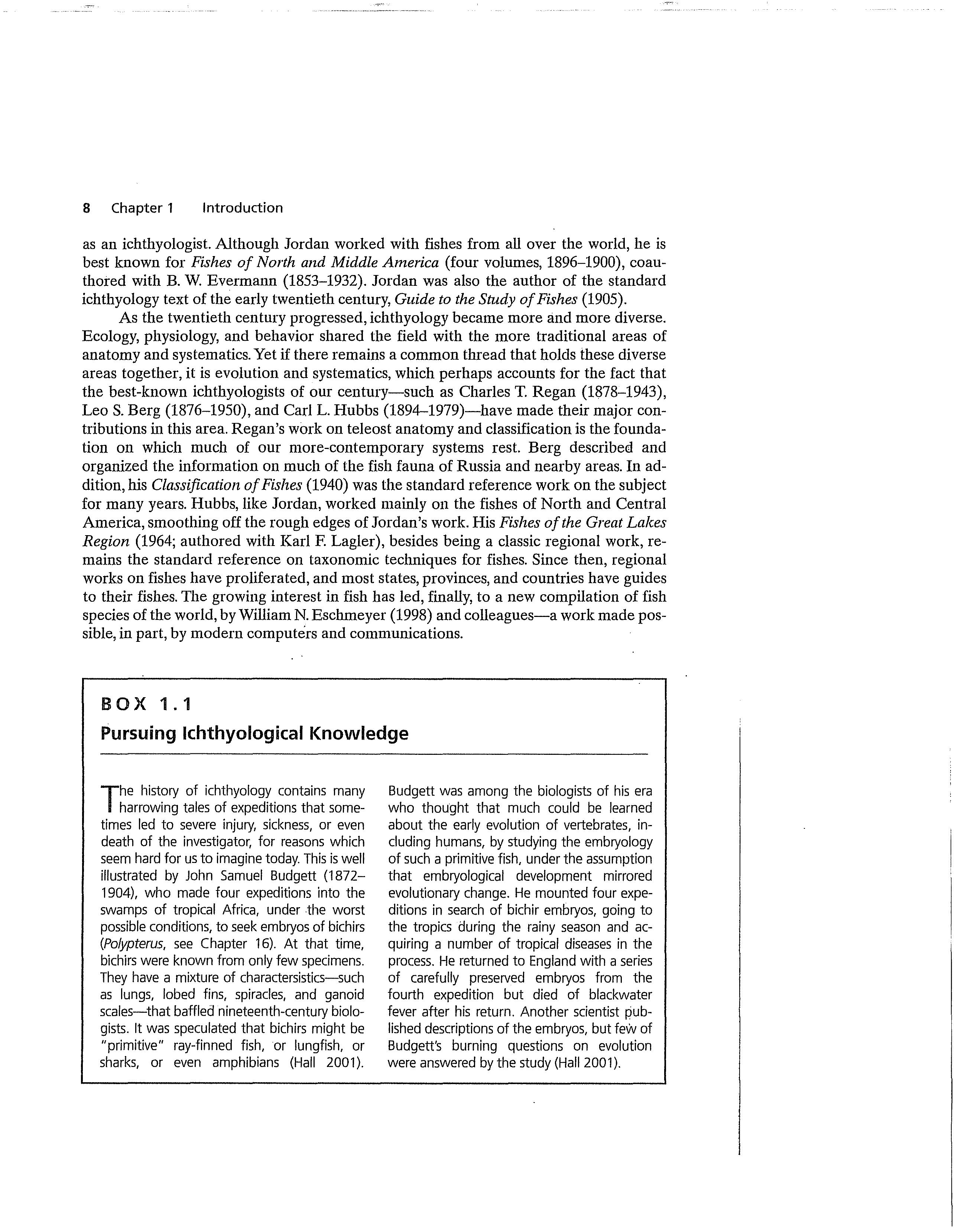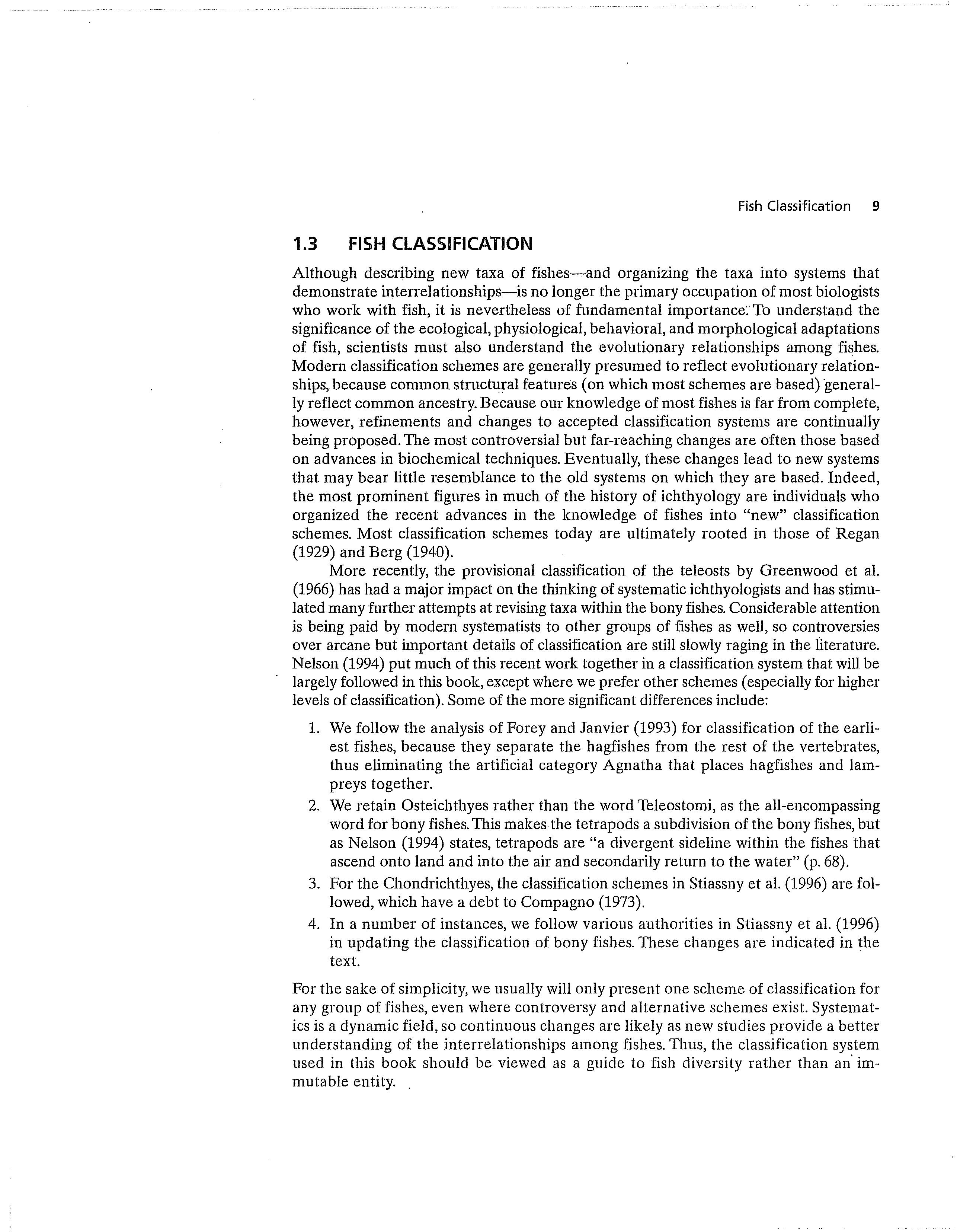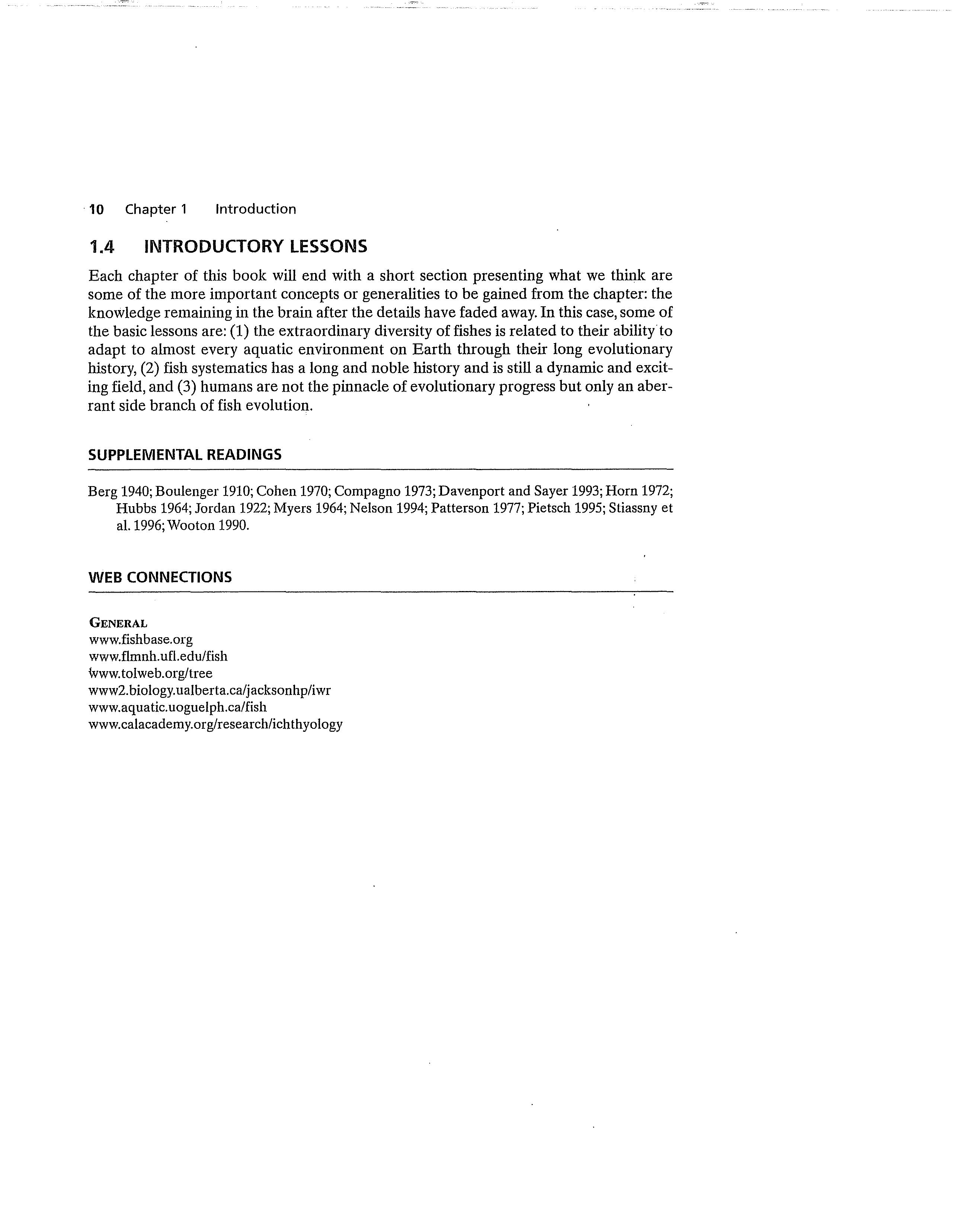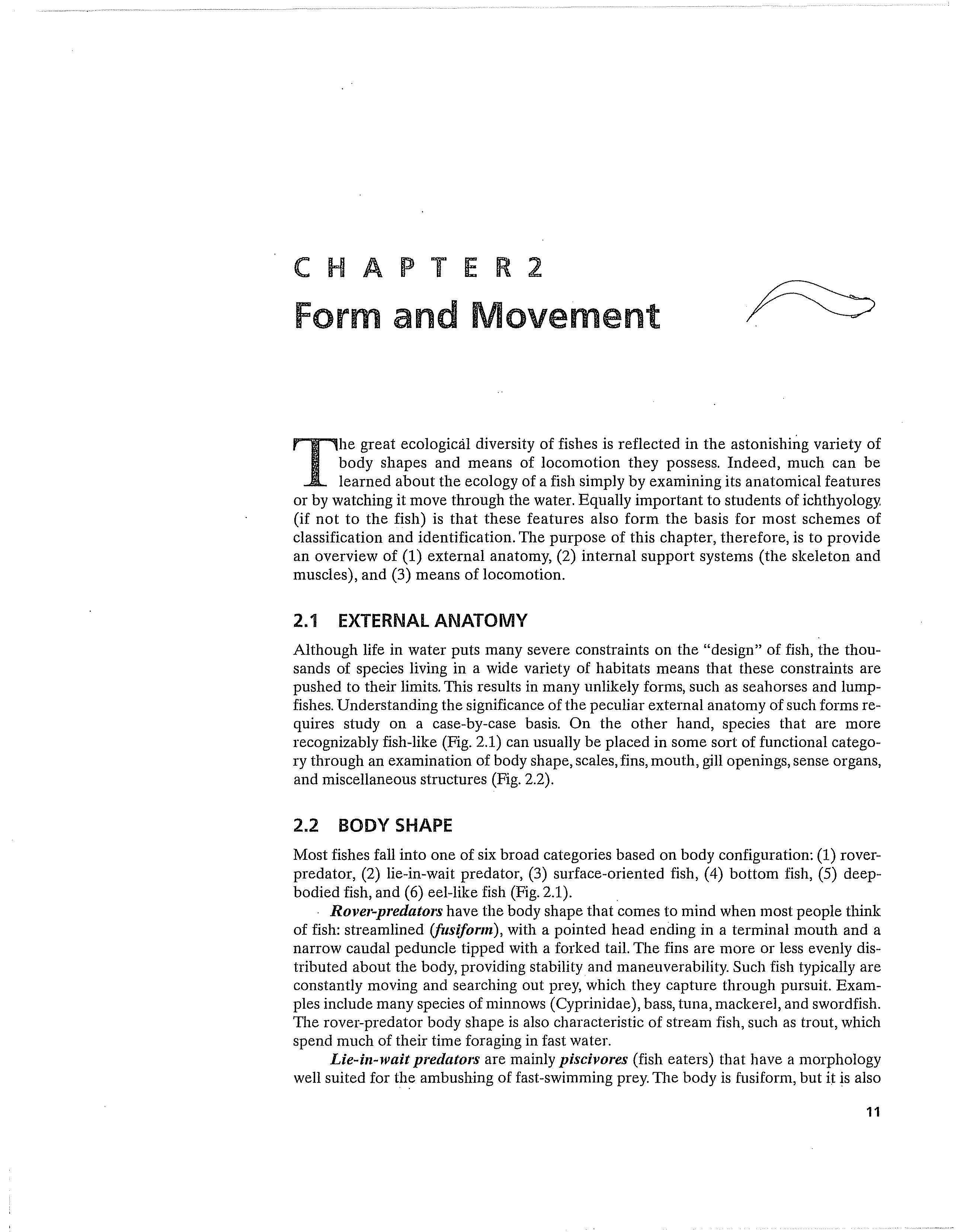Peter B. Moyle
Visit to download the full and correct content document: https://ebookmass.com/product/fishes-an-introduction-to-ichthyology-peter-b-moyle/
More products digital (pdf, epub, mobi) instant download maybe you interests ...
An Introduction to Parallel Programming. Second Edition
Peter S. Pacheco
https://ebookmass.com/product/an-introduction-to-parallelprogramming-second-edition-peter-s-pacheco/
ISE Introduction to Mass Communication (ISE HED B&B JOURNALISM) 11th Edition Stanley J. Baran
https://ebookmass.com/product/ise-introduction-to-masscommunication-ise-hed-bb-journalism-11th-edition-stanley-j-baran/
Enrique Dussel’s Ethics of Liberation: An Introduction 1st ed. Edition Frederick B. Mills
https://ebookmass.com/product/enrique-dussels-ethics-ofliberation-an-introduction-1st-ed-edition-frederick-b-mills/
An Introduction to Political Philosophy Jonathan Wolff
https://ebookmass.com/product/an-introduction-to-politicalphilosophy-jonathan-wolff/
Mirror for Humanity: A Concise Introduction to Cultural Anthropology (B&b Anthropology) 10th Edition, (Ebook PDF)
https://ebookmass.com/product/mirror-for-humanity-a-conciseintroduction-to-cultural-anthropology-bb-anthropology-10thedition-ebook-pdf/
Introduction to Managerial Accounting - Solutions Manual Fifth Canadian Edition Peter Brewer
https://ebookmass.com/product/introduction-to-managerialaccounting-solutions-manual-fifth-canadian-edition-peter-brewer/
Introduction to Graph Theory 2, 2002 reprint Edition
Douglas B. West
https://ebookmass.com/product/introduction-to-graphtheory-2-2002-reprint-edition-douglas-b-west/
Program Evaluation: An Introduction to an EvidenceBased Approach 6th Edition
https://ebookmass.com/product/program-evaluation-an-introductionto-an-evidence-based-approach-6th-edition/
An Introduction to Policing 9th Edition, (Ebook PDF)
https://ebookmass.com/product/an-introduction-to-policing-9thedition-ebook-pdf/
PETER B. MOYL'E
. 1-NTRODUCTION TO 1c :HTHYO LOGY
FIFTH -EDITION
ofhammer head sharks, like those ·shown on the front
:rhese geological radiate invisible
and "ndges" much.l1ke the spokes of a b1cycle wheel. The hammerheads use the1r
sense .to follow these "roads" to distant feeding grounds, fee.ding
on _squid ea.ch night "and returning to thei"r home bases at d.awn.
(Source ! A P. Klimley; "Hammerhead City·:. Naturaf History, vol. 104, p'p . 32 -39) ..
An lntroduction to lchthyology
FtFTH EDtTION
/ Peter B. Moyle
Joseph J. Cech1 Jr.
Department of Wildlife, Fish, and Conservation Biology University of California, Davis
San
Library of Congress
Data \ Moyle, Peter B. \ Fishes : an introduction to ichthyology 1 Pe ter B. Moyle, Joseph J. Cech, Jr.-5th ed. p. cm.
Includes bibliographical references and index.
ISBN 0-13-100847-1 l. Fishes. 2. Ichthyology. I. Cech, Joseph J. II. Title.
QL615.M64 2004 597-dc21
Assistant Editor: Calleen Lee
Executive Editor: Teresa Chung
Editorial Assistant: Mary Kuhl
Production Editor: Kevin Bradley
Manufacturing Manager: Trudy Pisciotti
Manufacturing Buyer: Lynda Castillo
Art Director: Jayne Con te
Cover Designer: Bruce Kenselaar
PONTIFICIA UNIVERSIDAO Ji\ VERIAN BIBLIO'I:ECA OEI'il.i:RAL AÓQUISICIONES
03054863
Cover Photograph & Diagram: Hammerhead sharks. Photo by Paul H. Humann. Diagram by Richard Ellis.
Art Editor: Jessica Einsig
Market Manager: Shari Meffert
© 2004,2000, 1996, 1988, publishing as Pearson Benjamín Cummings, 1301 San Francisco, CA 94111. All rights reserved. Manufactured in the United States · publication is protected by Copyright and permission should be obtained from the publisher prior to any prohibited reproduction, storage in a retrieval system, or transmission in any form or by any means, electronic, mechanical, photocopying, recording, or likewise. To obtain permission(s) to use material from this work, please submit a written request to Pearson Education, Inc., Pennissions Department, 1900 E. Lal<e Ave., Glenview, IL 60025. For information regarding permissions, call (847) 486-2635.
Many of the designations used by manufay&rers and sellers to distinguish their products are claimed as trademarks. Where those designations appear in this book, and the publisher was aware of a tr\demark claim, the designations have been printed in initial caps or all c;;¡ps. '
All rights reserved. No part of this book may be reproduced,in any form or by any means, without pennission in writing from the publisher.
Printed in the Unitecl S tates of America
10 9 8 7
ISBN 0-13-100847-1
Pearson Education Ltd., London
Pearson Education Australia Pty., Limited, Sydney
Pearson Education Singapore, Pte. Ltd.
Pearson Education North Asia Ltd., Hong Kong
Pearson Education Canada, Ltd., Toronto
Pearson Educación de Mexico, S.A. de C.V.
Pearson Education-Japan, Tolcyo
Pearson Education Malaysia, Pte. Ltd.
SBJ·
PREFACE XV
PART 1: INTRODUCTION 1
1
INTRODUCTION 1
Modern Fishes 1
History of lchthyology
Fish Classification 9 5
Introductory Lessons 10
Box 1.1 Pursuing Ichthyological Knowledge 8
Supplemental Readings 10 Web Connections 10
PART 11: STRUCTURE ANO fORM
2
11
FORM AND MOVEMENT
Externa! Anatomy 11 Body Shape 11
Scales 15
Fins 17
Other Structures 19
Skeletal System 20
Muscular System 23
Locomotion 26
Energetics of Swimming 31 11
Lessons from Form and Movement 34
Box 2.1 Hormones "Remodel" Salman Swimming Muscle 25
Box 2.2 Exercise Is Good for Fish Too! 34
Supplemental Readings 35 Web Connections 35
3
RESPIRATION 37
Gills 39
Air-Breathing Físhes 44
Fish Oxygen Requirements 46
Lessons from Respiration 49
Box 3.1 Living; Without Oxygen 46
4
5
Supplemental Readings 49
Web Connections 49
BLOOD ANO ITS CIRCULATION
Blood 51 51
Erythrocytes 52
Leukocytes 54
Hemoglobin 57
Circulation 65
Heart Structure 65
Myocardial Electrical Activity 68
Cardiac Flow 69
Cardiovascular Control 72
Secondary Circulation 74
Lessons from Blood and Circulation 75
Box 4.1 What Are the Cardiac Performance Limits of Fishes? 71
Supplemental Readings 75 Web Connections 75
BUOYANCY ANO THERMAL REGULATION 77
Buoyancy 77
Thennal Regulation 83
Lessons from Buoyancy and Thermal Regulation 87
Box 5.1 How Do J;<i.sh Inflate Their Swimbladder fofthe First Time? 79
Supplemental Readi.ngs 87
Web Connections 87
6
HYDROMINERA.l BALANCE 89
Osmoregulation 89
Ionic Regulation 92
Stress Responses and Effects 99
Freezing Resistance 104
Acid-Base Balance 106
Lessons from Hydromineral Balance 109
Box 6.1 Fish in "Hot Water": Warm Temperature-Related Losses of Smolt Characteristics 98
Box 6.2 Responses to Heat Shock (and Other) Stresses: Expression of Molecular Chaperones 101
Box 6.3 Stressful Rieles: Fish Responses to Transport a?d Handling 102
Supplemental Readings 109 1
Web Connections 109
.7 FEEDING, NUTRITION, DIGESTION, ANO EP<CRETION
Feeding 111 \. 111
Nutrition 117
Digestion and Absorption 122
Excretion 124
Lessons from Feeding, Nutrition, Digestion, and Excretion 125
Box 7.1 Brain Peptides Help Regulate Appetite in Fishes 114 . Box 7.2 Fish Use Polarized Light to Locate Prey 114 \ Box 7.3 Adrenaline Regulates Fish Blood Sugar Ú9 / Supplemental Readings 126 Web Connections 126
GROWTH
127
Factors Affecting Growth 127
Growth Regulation 133
Growth Rate Measurements and Models 134
Lessons from Growth 139
Box 8.1 Bar Stone Analyses Reveal Life History
Supplemental Readings 139 Web Connections 139
9
138
REPRODUCTION 141
· -:Reproductive Anatomy 141 Breeding Behavior 143 Development 148
Physiological Adaptations 151 Bioenergetics 154
Mating Systems 160
Alternative Reproductive Strategies 161 Sex Change in Fish 164
Lessons from Fish Reproduction 165
Box 9.1 High and "Dry": Beach Spawning in the Grunion 145 Box 9.2 Feminization of Mal e Fish by Endocrine , Disrupting .Chemicals 153
1 Box 9.3 American Shad: Why Sorne Die, and Why Sorne Do Not \ Box 9.4 TI1e Mystery of An All-Male "Species" 163 \ Supplemental Readings 165 '.,Web Connections 165
SENSORY PERCEPTION 167
Chemoreception 167
Olfaction 167
Taste 169
Acousticola teralis System 170
Hearing 171
Equilibrium and Balance 173
Lateral Line 175
Electroreception/Magnetoreception 177
Vision/Photoreception 180
Lessons from Sensory Perception 185
Box 10.1 Finding the Way Back Using Familiar Odors 169
Box 10.2 Do Large Brains Make Smarter Fish? 179
Supplemental Readings 185 Web Connections 185
BEHAVIOR AND COMMUNICATION 187
Migratory Behavior
Shoaling Behavior
Feeding Behavior
Aggressive Behavior 187 192 196 197
Communication 198
Lessons from Fish Behavior and Communication 206
Box 11.1 The Complex Movements of Atlantic Bluefin 1\.ma
Box 11.2 Do Fish Sleep? 198
Supplemental Readings 207 Web Connections 207
SYSTEMATICS, GENETICS, AND SPECIATION 209
Taxonomic Methods 210
Gene tic Variability 213
· Speciation 214
Hybridization 217
Nomenclature 218
Lessons from Fish Systematics, Genetics, and Speciation 220
Box 12.1 The Nature of Species: Arctic Charr 216
Box U.2 111e Complex History of Rainbow Trout 219
Supplemental Readings 220 Web Connections 220
EVOLUTION 221
TI1e Earliest Vertebra tes 221
Ostracoderms 224
Placoderms 225
Chondrichthyes 226
Acanthodü 229
Osteichthyes 230
Sarcopterygii 231
Actinopterygii 235
Structural Changes in Actinopterygians
Evolutionary Trends Within the Teleosts
Lessons from Fish Evolution 242
238 240
190 / 1
15
16
Box 13.1 The Origin of Jaws 227
Box 13.2 Picturing Ancient Fishes 232
Supplemental Readings 243 Web Connections 243
HAGFISHES
ANO lAMPREYS 245
Hagfishes 245
Lampreys 248
Lessons from Hagfishes and Lampreys 252
Box 14.1 Hagfish Leather 248
Box 14.2 TI1e Great Sea Lamprey Invasion
Supplemental Readings 253 Web Connections 253 252
SHARKS, RAYS, ANO CHIMAERAS
Characteristics 257
Adaptations 258
Reproduction 262
Diversity 265
Elasmobranchii 265
Holocephali 272
Lessons from the Chondrichthyes 272
255
17
Box 15.1 What Is the Hammer Head for? 261
Box 15.2 World's Largest Fish 268
Box 15.3 The Cookie-Cutter Shark, Ambush Predator
Supplemental Readings 273 Web Connections 273
REUCT BONY FISHES 275
Sarcopterygii 276
Dipnomorpha (Dipnoi) 276
Actinistia: Coelacanths 277
Actinopterygii 279
Polypteriformes 279
Acipenseriformes 280
Lepisosteiformes 282
Amiiformes 283
Lessons from Relict Bony Fishes 284
Box 16.1 The Second Coelacanth 278
Supplemental Readings 284 Web Connections 284
BONYTONGUES, EElS, AND HERRINGS
Teleostei 285
Osteoglossomorpha 286
Elopomorpha 290
Contents
Elopiformes 290
Albuliformes 291
Anguillifonnes 292
Saccopharyngifonnes 294
Clupeomorpha 295
Lessons from Bonytongues, Eels, and Herrings 298
Box 17.1 Are All Anguillid Eels Catadromous? 293
Box 17.2 Freshwater Herrings 296
Supplemental Readings 298
Web Connections 298
MINNOWS, CHARACINS, AND CATFISHES 299
Gonorynchifonn('!s 300
Otophysi 302
Cypriniformes 303
Characifonnes 307
Siluriforrnes 308
Gymnotiformes 315
Lessons from Minnows, Characins, and Catfishes 316
Box 18.1 Common Carp: Super Fish 306
Box 18.2 TI1e Remarkable Pangasüd Catfishes of the Mekong River
Box 18.3 Electric Eels: Shocking Predators 316
Supplemental Readings 317
Web Connections 317
SMELT, SAlMON, ANO PIKE 319
Argentiniformes 320
Salmonifonnes 321
Osmeroidei 321
Salmonoidei 324
Esociformes 328
Lessons from Smelt, Salmon, and Pike 329
Box 19.1 Galaxiids: Small Fish in Remote Places
Box 19.2 Special N ames for Special Fishes 326
Supplemental Readings 329 Web Connections , 329 323
ANGlERFISH, BARRACUDINAS, CODS, ANO
Stenopterygii
Cyclosquamata
Scopelomorpha
Lampridiomorpha
Polymixiomorpha
Paracanthopterygü
Percopsiformes 340
Ophidiiformes 340
Gadiformes 342
Batrachoidiformes 344
Lophiiformes 345
Lessons from Odds and Cods 345
Box 20.1 Fish as Parasites: The Pearlfishes 342
Supplemental Readings 347 Web Connectioris 347
MULLETS, SILVERSIDES, FLYING FISH, AND I<ILLIFISH
Mugilomorpha 350
Atherinomorpha 351
Atheriniformes 351
Beloniformes 353
Cyprinodontifonnes 355
Lessons from the Atherinomorpha 359
Box 21.1 Do Flying Fishes Really Fly? 355
Box 21.2 Devils Role: Smallest Range of Any Species 357
Supplemental Readings 360 Web Connections 360
OPAHS, SQUIRRELFISH, DORIES, PIPEFISH, AND SCULPINS
361
Percomorpha 362
Stephanoberyciformes and Beryciformes 364
Zeifonnes 365
Gasterosteiformes 365
Synbranchiformes 369
Dactylopteriformes 371
Scorpaeniformes 371
Lessons from Percomorphs 375 Box 22.1 Pregnant Males 369 Box 22.2 World's Longest-Lived Fish? 372
Supplemental Readings 376 Web Connections 376
PERCIFORMES: SNOOI<S TO SNAI<EHEADS
Percoidei 379
Elassomatoidei 384
Labroidei 386
Zoarcoidei 389
Notothenioidei 390
x Contents
Trachinoidei
Blennioidei
Icosteoidei 391 391 393
Gobiesocoidei
Callionymoidei
Gobioidei 394
Kurtoidei 396 393 393
Acanthuroidei
Scombroidei
Stromateoidei
Anabantoidei
Channoidei 396 396 400 401 402
More Lessons from the Percomorpha 402
Box 23.1 Nature's Grand Experiment in Evolution 386
Box 23.2 Color and Sex Change in Parrotfishes and Wrasses 389
Box 23.3 World's Smallest Fishes 395
Supplemental Readings 403 Web Connections 403
2
FlOUNDERS, PUFFERS, ANO MOLAS
Pleuronectiformes 405
Tetraodontiformes · 409
Lessons from Flatfish and Puffers ·411
Box 24.1 Floundering for N ames 408
Box 24.2 Fugu Fa,me 410
Supplemental Readings 412 Web Connections 412
PART IV: ZOOGEOGRAPHY 413
ZOOGEOGRAPHY OF FRESHWATER FISHES 413
Zoogeographic JYpes 413
Zoogeographic Regions 415
African Region 416
Neotropical Region 418
Oriental Region 420
Palaearctic Regioil 422
North American Region 422
Australian Regían 431 \
PlateTectonics and the Distribution of Fresliwater Fishes 432
Pleistocene Glaciation 434
Lessons from Freshwater Zoogeography
Box 25.1 Madagascar: A Refuge for Relict Fishes 417
26
Box 25.2 Lalce Baikal: Center of Speciation 423
Box 25.3 Mississippi River as a Refuge for Fishes 426
Supplemental Readings 436
Web Connections 436
ZOOGEOGRAPHY Of MARINE FISHES ---437
Continental Shelves 438 )
Tropical Regions 438
North Temperate Regions 442 /
Arctic Region 446
South Tempera te Regions 446
Antarctic Region 448
Pelagic Regions 448
Deepsea Regions 450
Antitropical Distribution Patterns 451
Lessons from Marine Zoogeography 452
Box 26.1 The Suez Canal: An Experiment in Zoogeography · 440
Box 26.2 St. Helena: Evidence of Long-Distance Dispersa! in Fishes? 442
Supplemental Readings 453
Web Connections 453
PART V: ECOlOGY 455
27
28
INTRODUCTION TO ECOlOGY 455
Filters 455
Predation 458
Competition 460
Symbiosis 463
Parasites and Pathogens 465
Lessons from Fish Ecology 467
27.1 Cannibalism: A Special Kind of Predation 458
Box 27.2 Intraspecific Competition: An Important Regulatory Mechanism in Fishes 462
Supplemental Readings 468
Web Connections 468
TEMPERATE STREAMS 469
Physical Factors 469
Chemical Factors 473
Biological Factors 473
Zoogeographic Factors 478
Zonation 479
Fish Assemblages 481
The Role of Fish in Stream Ecosystems 482
Lessons from Stream Fishes 483
Box 28.1 The Stoneroller: Mover and Shaker in Streams of the Eastern United States 474
Box 28.2 Shigeru Nakano's Legacy of Stream Studies 483
Supplemental Readings 484
Web Connections 484
TEMPERATE LAKES ANO RESERVOIRS 485
Physical Factors 485
Chemical Factors 488
Temporal Factors 490
Biological Factors 492
Zoogeographic Factors 496
Fish Zones 496
Reservoirs 498
Lessons from Lake Fishes 501
Box 29.1 Fish Integra te Benthic and Pelagic Foodwebs in Lakes
Box 29.2 Lake Ecosystem Changes Lead to Road-Killed Bald Eagles
Supplemental Readings 501
Web Connections 502
TROPICAl FRESHWATER lAKES ANO STREAMS
Physical Factors
Chemical Factors
Biological Factors
Fish Communities 504 506 507 510
Fish as Major Players in Tropical Ecosystems 516
Speciation in African Cichlids 517
Lessons from Tropical Fishes 520
Box 30.1 Symbiotic Interactions Among Fishes in African Lakes 510
Supplemental Readings 520
Web Connections 520
ESTUARIES 521
Characteristics of Estuaries 521
Estuarine Fishes 522
Factors That Affect Distribution
Food Webs 528
Fish Communities 529 524
Lessons from Estuarine Fishes 530
Box 31.1 Life on the Edge: Fish in a Newfoundland Estuary 527
32
33
Box 31.2 Long- Term Changes in a Portuguese Estuary 529
Supplemental Readings 531
Web Connections 531
COASTAL
HABITATS
533
Rocky Intertidal Areas 533
Exposed Beaches 536
Mudflats 537
Salt Marshes 538
Mangrove Swamps 540
Sea Grass Flats 541
Kelp Beds 542
Near-Shore Rocky Bottoms 544
Near-Shore Soft Bottoms 546
Hypersaline Lagoons and Salt Ponds 551
Lessons from Coastal Fishes 552
Box 32.1 How Offshore Fisheries Affect Kelp Bed Fishes 545
Supplemental Readings 553
Web Connections 553
TROPICAl REEFS 555
The Reef Environment 556
Types of Reef Fishes 557
Species Interactions 561
Activity Patterns 564
Reproduction 565
Early Life History 566
Community Structure 567
Lessons from Tropical Reef Fishes 569
Box 33.1 Peaceful Coexistence Among Anemonefishes 563
Box 33.2 Stay-at-Home Cleaner Gobies 567
Supplemental Readings 570
Web Connections 570
34
EPiPElAGIC ZONE 571
Adaptations for Pelagic Life 571
Ecological Types 572
Physical Factors 573
Chemical Factors 576
Biological Factors 576
Migrations and Movements 578
Pacific Sardine 579
Lessons from Epipelagic Fishes 582
Box 34.1 Ocean Conditions and the Decline ofWild Atlantic Sallnon 573
Box 34.2 Tuna FADs 575
Supplemental Readings 583
Web Comiections 583
DEEP SEA HABITATS 585
Diversity 585
Adaptations 586
Reproductive Strategies 589
Ecology 590
Lessons from Deep Sea Fishes 595
Box 35.1 Lilliputian Fishes of the Southern Atlantic
Box 35.2 How Do Anglerfishes Coexist? 593
Supplemental Readings 596
Web Connections 596
POlAR REGIONS 597
Arctic Fishes 597
Antarctic Fishes 599
Adaptations 599
Factors Affecting Distribution 601
Fish Communities 602
Evolution of a Species Flock 604
Lessons from Polar Fishes 605
Box 36.1 Contaminants in an Arctic Shark 598
Box 36.2 Learning About the Behavior of Fish Under Ice
Supplemental Readings 606
Web Connections 606
CONSERVATION 607
Status of Fish Faunas 607
Causes of Declines in Fish Diversity and Abundance 611
Aquaculture 618
Fisheries Management 619
Reserves 621
Economic Values of Fish 622
Non-Economic Values of Fish 626
Fish Conservation in the Real World 628
Conclusións 634
The Final Lesson 635
Box 37.1 Biotic Homogenization:A World Trend 614
Box 37.2 Loss of Fish Diversity Causes Loss of Mussel Diveroity 617
Box 37.3 Fish in the Bank 625
Supplemental Readings 636
Web Connections 636 "-
BIBUOGRAPHY 637
INDEX 711
PREFACE
Ichthyology has traditionally emphasized the systematics, anatomy, and distribution-._. of fishes. In the past, most prominent names associated with the field made their majar contributions in these areas. Toda y, however, people who study fish have more far-reaching interests. They study fish to find ways to improve fisheries or aquaculture, to determine the effects of hllil.'l:all activities on aquatic environments, and to test ideas in rapidly developing fields, such as ecology, physiology, behavior, and evolution. Growing numbers of sophisticated amateur ichthyologists desire to increase their understanding of fish they keep in aquaria or of those they pursue with hook and line. Regardless of why fish are studied, those studying them still need the basic vocabulary and understanding of fish biology that traditional are as of emphasis provide and that are found in this book, integrated with recent developments in other areas. Our goal is to provide sorne feeling for the excitement engendered by recent research on fishes. We also want to promote a sense of urgency for the need to protect fishes and aquatic ecosystems. It is critica! that a high diversity of fishes continue to be around to fascina te future generations.
In large part, this book is designed to serve as a text in classes on fish biology. The large number of chapters and the cross-references within chapters provide instructors of such courses with flexibility when assigning readings in the text. The students we had in mind while writing were junior- and senior-leve! university students. Our goal, however, is also to provide a useful and palatable summary of recent developments in ichthyology for individuals who ha ve been away from the college classroom for sorne time and for anyone else who wants an introductioli to the most numerous, diverse, and fascinating of all vertebrate groups.
This book would not have been possible without the encouragement and help of many people. Initial stimulation and support in fish biology was provided by John B. Moyle, Evelyn W. Moyle, and James C. Underhill (to P.B.M.) and by Donald E. Wohlschlag (to J.J.C.). Gary D. Grossman, Donald M. Baltz, and Robert A. Daniels were especially helpful in developing the first versions of many chapters. Numerous graduate and undergraduate students contributed valuable comments on various chapters and/or helped to keep our research programs going while we devoted time to writing. We benefited from discussions with Jeff Graham, Fred White, Tony Farrell, Alan Heath, Carl Schreck, Monica Choi, Stephanie Chun, Hiram Li, Ken Gobalet, Dave Randall, Mikko Nikinmaa, George V. Lauder, Laurie Sanderson, Chris Myrick, Cincin Young, Tina Swan·son, Carlos Cracker, Shana Katzman, Ann Houck, Ryan Mayfield, Marianne Brick, Keith Marine, Michael Karogosian, Peter Wainwright, and Serge Doroshov. The expert editorial assistance of Chris Myrick and Julie Roessig was especially appreciated during preparation of the fourth and fifth editii:ms, respectively. Ms. Roessig also contributed severa! original figures to the fifth edition. Trilia Chen also contributed an original figure and editorial assistance to the fifth edition. The reviews of selected chapters in previous editions by Eugene Balon, Michael Bell, David Ehrenfeld, Dale Lott, John Radovich,Arnold Sillman, Randolph Smith, and Paul Webb are appreciated, as are comments by Brooks Burr, Barbara Block, Alfred Ebeling, Kurt Fausch, Malcolm Gordon, Bruce Herbold, Mark Hixon, Paul James, Douglas Markle, John McEachran, Lawrence
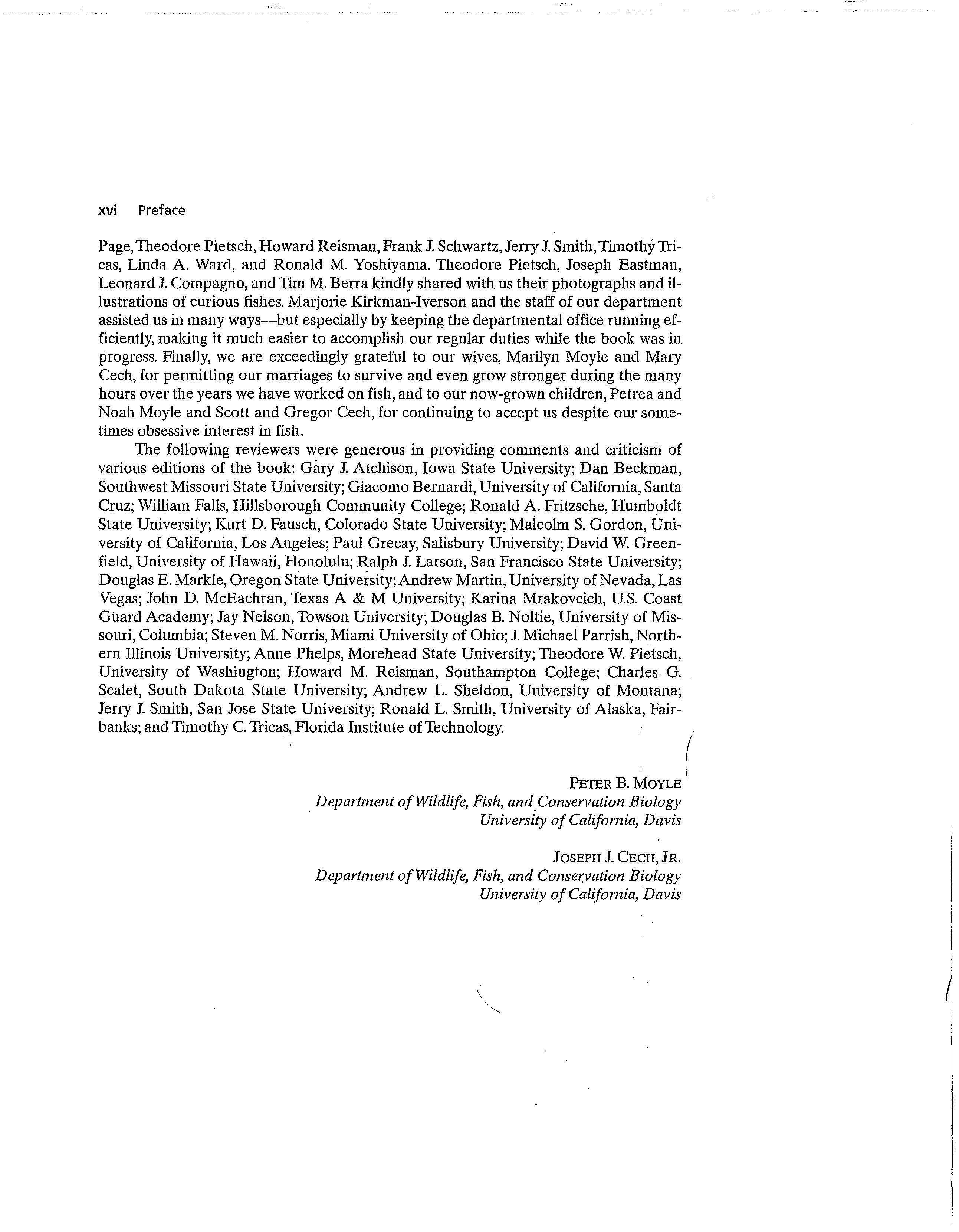
){Vi Preface
Page, Theodore Pietsch, Howard Reisman, Frank J. Schwartz, Jerry J. Smith, Timothy Tricas, Linda A. Ward, and Ronald M. Yoshiyama. Theodore Pietsch, Joseph Eastman, Leonard J. Compagno, and Tim M. Berra kindly shared with us their photographs and illustrations of curious fishes. Marjorie Kirkman-Iverson and the staff of our department assisted us in many ways-but especially by keeping the departmental office running efficiently, making it much easier to accomplish our regular duties while the book was in progress. Finally, we are exceedingly grateful to our wives, Marilyn Moyle and Mary Cech, for pennitting our marriages to survive and even grow stronger during the many hours over the years we have worked on fish, and to our now-grown children, Petrea and Noah Moyle and Scott and Gregor Cech, for continuing to accept us despite our sornetimes obsessive interest in fish.
The following reviewers were generous in providing comments and criticisril of various editions of the book: Gary J. Atchison, Iowa State University; Dan Beckman, Southwest Missouri State University; Giacomo Bernardi, University of California, Santa Cruz; William Falls, Hillsborough Community College; Ronald A. Fritzsche, Humboldt State University; Kurt D. Fausch, Colorado State University; Malcolm S. Gordon, University of California, Los Angeles; Paul Grecay, Salisbury University; David W. Greenfield, University of Hawaii, Honolulu; Ralph J. Larson, San Francisco State University; Douglas E. Markle, Oregon S tate U niveÍ'sity; Andrew Martín, U niversity of N evada, Las Vegas; John D. McEachran, Texas A & M University; Karina Mrakovcich, U.S. Coast Guard Academy; Jay Nelson, Towson University; Douglas B. Noltie, University of Missouri, Columbia; Steven M. Norris, Miami University of Ohio; J. Michael Parrish, Northern Illinois University; Anne Phelps, Morehead State University; Theodore W. Pietsch, University of Washington; Howard M. Reisman, Southampton College; Charles G. Scalet, South Dakota State University; Andrew L. Sheldon, University of Montana; Jerry J. Smith, San Jase State University; Ronald L. Smith, University of Alaska, Fairbanks; and Timothy C.1ricas, Florida Institute ofTechnology.
PETER B. MüYLE
Department ofWildlife, Fish, and. Conservation Biology University of California, Da vis
J OSEPH J. CECH, J R. Department ofWildlife, Fish, and Conse1:vation Biology University ofCalifomia, Davis
lntroduction
1.1
MODERN FISHES
The.Ji§he.§.._ are the most and di verse of the majar vertebr¡;¡te groups. They domínate the 'waters-óf Ü1e worid through a marvelous variety of morphologiéai; physiological, and behavioral adaptations. TI1eir diversity is reflected in the large number of living fish species. A recent compilation of fish species (Eschmeyer 1998) lists 23,250 species with valid descriptions but estimates the number is ·actually around 25,000. Because about 200 new fish species are being described each year, the total may reach 30,000 or more!
Fish occupy an extraordinary arra y of habitats. They can be found thriving in seasonal ponds, intermittent streams, tiny desert springs, the vast reaches of the open oceans, deep oceanic trenches, cold mountain streams, saline coastal embayments, and so on through a nearly endless list of aquatic environments. )?hy8iologic;;ªl!y, this means that species of fish can be fotmd at temperatures ranging from -1.8°C to rÍearÍy 40 6 C, · in water wiih pH values ranging-from 4-to 10+ and dissolved oxygen levels ranging from clase to· zero to salinitles ranging from Oto 90 ppt, aó.d at depths (with sociated pressures). fi·om Oto 7,000 m (Davenport and Sayer 1993).
The diversity of fish and their habitats reflects their long evolutionary history and the willingness of ichthyologists to include the jawless hagfishes and lampreys within their definition ofjish. Modern fishes (and vertebra tes in general) consist of three majar groups that have been going their own evolutionary ways for at least 500 million years (Fig. 1.1). The line with the most ancestraP characteristics (Myxini) is that of the es (Myxiniformes, 40+ species), which arguably are not even vertebrates. They may represent, however, an offshoot of the group that did give rise to the vertebrates. The first unquestioned vertebrates were a loase group of jawless fishes (ostracoderms) that are represented in the modern fauna by lampreys (Petromyzontifonnes, 40+ species). TI1eir heyday was 350 to 500 million years ago, and they had surprising diversity despite their small size and !acle of jaws and paired fins. TI1ese forms, in turn, presumably gave rise to the jawed vertebrates (Gnathostomata), which are the vertebrates that domínate our planet today. The jawed fishes divided into three distinct groups early in their evolution: the now-extinct placoderms (Placodermi), the cartilaginous fishes (Chondri'chthyes),
'The terms ancestral and deri1>etl are used throughout this book instead of the more traditional primitive and advanced to avoid connotations of "inferior" and "superior," respectively.
Chapter 1 lntroduction
Myxiniformes (hagfishes)
ctl Petromyzontiformes (lampreys) 1ií "§
Holocephali (chimaeras)
Elasmobranchi (sharks)
Tetrapoda
Dipnomorpha (lungfishes)
Actinistia (coelacanths)
Polyteriformes (bichirs) 2
Acipenseriformes (sturgeons)
Lepisasteiformes (gars) g, Amiiformes (bawfin)
Teleastei
FIGURE 1.1 Branching diagram showing the interrelationships af the majar groups af modern fishes, lampreys, and hagfishes (craniates). In this scheme, each branching represents a majar evalutionary divergence, with each split consisting of two sister gro11ps. Thus, the hagfishes (Myxiniformes) are regarded as the sister group to the lampreys (Petramyzontifarmes) plus all jawed whereas the lampreys are the sister graup to all ather fishes.
and the bony fishes (Osteichthyes). The aberrant bony fishes that decided to1leave the water and invade the land became modern tetrapods.
The cartilaginous fishes split into two distinct lineages early in their history: the sharks and rays (Elasmobranchi), and the ratfishes and chimaeras (Holocephali). There are more than 800 living species of sharks and rays and approximately 30 species of chimaeras and ratfishes. The bony fishes also split into a number of evolutionary lineages early in their history, although the exact nature of these lineages is debated. The major groups of bony fishes represented in the modern fauna are the lungfishes (Dipnoi, six species), the coelacanths (Coelacanthiformes, two species), and the ray-finned fishes (Actinopterygii). Living ray-finned fishes represent two distinct Iines. The Chondrostei
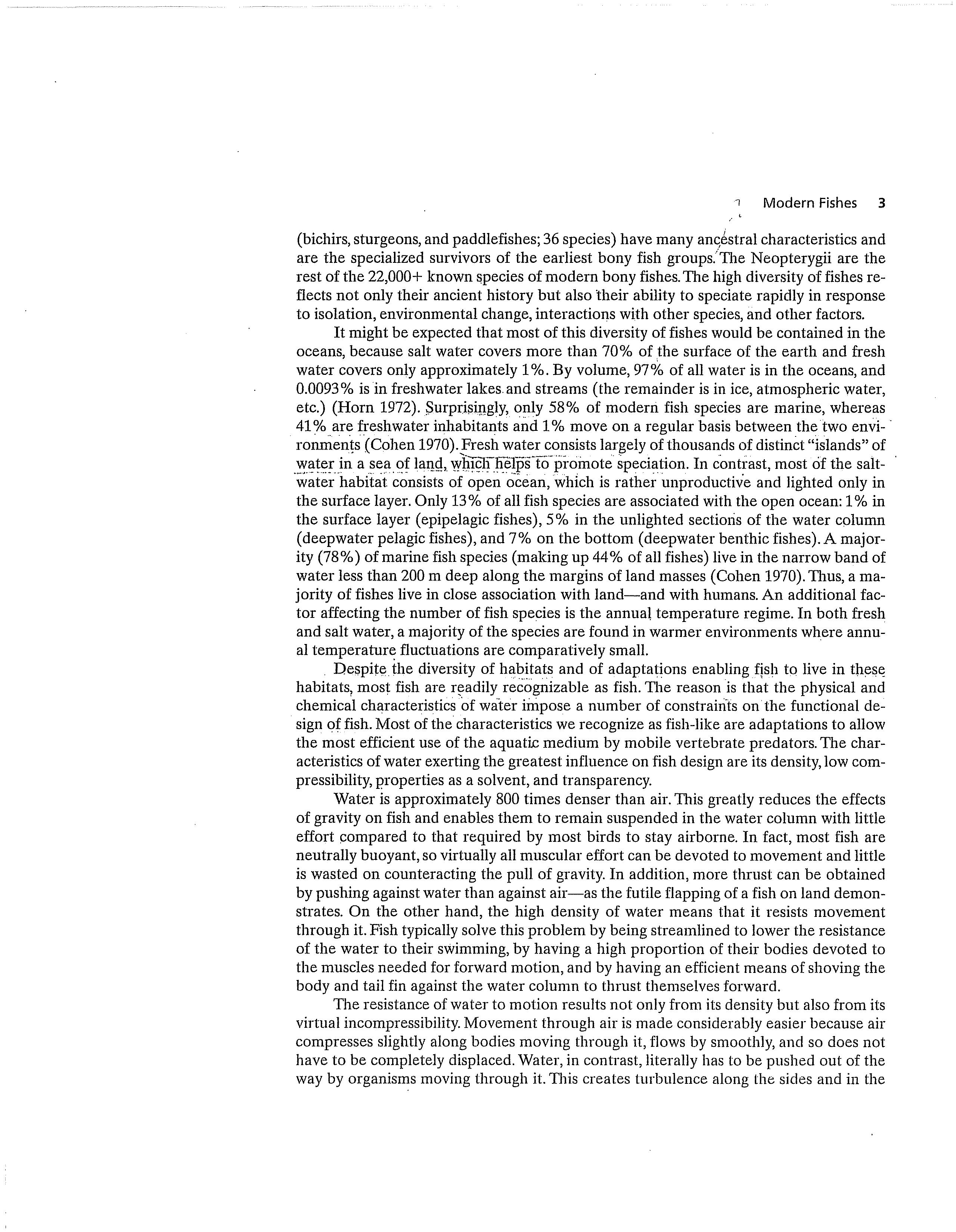
-, Modern Fishes 3 (bichirs, sturgeons, and paddlefishes; 36 species) have many anc;éstral characteristícs and are the specialized survivors of the earliest bony fish groups.'The Neopterygii are the rest of the 22,000+ known &pecies of modern bony fishes. The high diversity of fishes reflects not only their ancient history but also their ability to speciate rapidly in response to isolation, environmental change, interactions with other species, and other factors. It might be expected that most of this diversity of fishes would be contained in the oceans, because salt water covers more than 70% of the surface of the earth and fresh water covers only approximately 1%. By volume, 97o/o of all water is in the oceans, and 0.0093% is in freshwater lakes. and streams ( the remainder is in ice, atmospheric water, etc.) (Horn 1972). Surprisip,gly, only 58% of modern fish species are marine, whereas 41% are freshwater inhabitants and 1% move on a regular basis between thetwo envi-. ronrrien!s ( Cohen 1970). Fresh water consists largely of thousands of distinct "islands" of a laf!Q, whTªffi.e1psTo-pÍ'oinote speciation. In contrast, most of the salíwater habitát consists of open o'Céan, wh1ch is rather unproductive and lighted only in the surface !ayer. Only 13% of all fish species are associated with the open ocean: 1% in the surface layer (epipelagic fishes), 5% in the unlighted sectioris of the water column (deepwater pelagic fishes), and 7% on the bottom (deepwater benthic fishes).A majority (78%) of marine fish species (making up 44% of all fishes) Iive in the narrow band of water less than 200m deep along the margins of land masses (Cohen 1970). Thus, amajority of fishes live in clase association with land-and with humans. An additional factor affecting the number of fish species is the annual temperature regime. In both fresh and salt water, a majority of the species are found in warmer environments where annual temperature fluctuations are comparatively small.
Despitt3the diversity of habitats and of adaptations enabling fjsh to live in habitats, most fish are reeognizable as fish. reason is thát the physical and chemical characteristics of water impose a number of constrairús on the functional design of fish. Most of the characteristics we recognize as fish-like are adaptations to allow the most efficient use of the aquati.c medium by mobile vertebra te predators. The characteristics of water exerting the greatest influence on fish design are its density, low compressibility, properties as a solvent, and transparency.
Water is approximately 800 times denser than air. This greatly reduces the effects of gravity on fish and enables them to remain suspended in the water column with little effort compared to that required by most birds to stay airborne. In fact, most fish are neutrally buoyant, so virtually all muscular effort can be devoted to movement and little is wasted on counteracting the pull of gravity. In addition, more thrust can be obtained by pushing against water than against air-as the futile flapping of a fish on land demonstrates. On the other hand, the high density of water means that it resists movement through it. Fish typically sol ve this problem by being streamlined to lower the resistance of the water to their swimming, by having a high proportion of their bodies devoted to the muscles needed for forward motion, and by having an efficient means of shoving the body and tail fin against the water column to thrust themselves forward.
The resistance of water to motion results not only from its density but also from its virtual incompressibility. Movement through a iris made considerably easier beca use air compresses slightly along bodies moving through it, flows by smoothly, and so does not have to be completely displaced. Water, in contrast, literally has to be pushed out of the way by organisms moving through it. This creates turbulence along the sides and in the
4 Chapter 1 lntroduction
wake of the organism, which increases further the drag of the water.The incompressibility of water crea tes problems for fish, but they are also able to take advantage of it. Each fish has an extremely sensitive sensory system, the lateralline system, that can detect small amounts of turbulence and water displacement created either by its own motion or by that of other organisms or objects. Using this system, fish can detect nearby stationary objects, other fish, and food organisms. The lateralline system is particularly usefui when visual cues are lacking. Fish (mainly teleosts) also use the incompressibility of water to help them in eating and breathing: Quick expansion of the mouth and gill chambers allows water to rush in, carrying food and oxygen into the chambers along with the water. This "pipette effect" is particularly well developed in fishes that feed on small, mobile organisms, and it resuits in jaw structures very different from those of terrestrial vertebrates.
Water behaves as if it is incompressible for the purposes of movement, feedirig, and breathing of fish, but it can be compressed slightly. This is fortunate, because it enables sound to be carried. In fact, sound is carried farther and faster in water than it is in air (1,433 m/s versus 335 m/s) thanks to the greater density of water. As a consequence, most fish have an excellent sense of hearing, even though they lack the extemal ears associated with hearing in terrestrial vertebrates. Externa} ears are not needed, because fish tissue is roughly the same density as water and so is nearly transparent to sound waves. However, the sound waves can be intercepted intemally by structures that are either much denser than water (otoliths) or much less dense than water (swim bladders). Beca use most fish can hear well, it is not surprising that many also malee sounds for communication. A single toadfish, for example, when engaging in its courtship rites can produce sound that may reach 100 dB in loudness. The "silent world" of the oceans is largely a myth, at least as far as fish are concerned!
Perhaps the most important characteristic of water that enables it to support life, including fish, is its property as the nearly universal solven t. The waters of the world ·contain complex mixtures of gases, salts, and organic compounds, many of which are needed by fish to sustain life and are taken up either directly through the gills or indirectly through food organisms. The most important of the gases is oxygen, which is present in extreme} y small amounts compared with that found in air (1 to 8 ml of oxygen per liter of water versus 210 ml of oxygen per liter of air). Although the gills of fish are incredibly efficient at extracting oxygen from water, the low availability of oxygen !n water canlimit their metabolic activity. To maximize their ability to extract oxygen from the water, fish expose a large gill-surface area to the water, bringing their blood in close contact with the environment to facilitate gas exchange. Not surprising!y, other stances carried in the blood also pass between the environment and the fish. Fish eliminate waste products (especially carbon dioxide, ammonia, and heat) through the gills, but they also take in harrnful substances, including pollutants such as heavy metals and pesticides. The large area of exposed gill also malees fish very sensitive to changes in the concentration of salts in the water, accounting, in part, for the difficulty most fish have in moving between fresh and salt water. ·
A final important characteristic of water to fish is its low penetrability to light compared with that of air. Even in the clearest water, light seldom penetrates deeper than 1,000 m, and in most water, the depth of penetration is considerably less. Becai.Ise
History of lchthyology 5
the lighted (photic) zone is where algae and aquatic plants grow and where grazing invertebrates are concentrated, it is not surprising that most fish are found there. Indeed, a majority of fish rely primarily on sight for prey capture. However, many fishes have sensory structures, such as barbels and electric organs, that allow them to find their way about at night, in muddy water, or in other low-light situations. Below the lighted zone of the oceans are complex communities of fish that produce their own light, both to signal each other and to attract prey.
As the following chapters will reveal, there are many exceptions to the preceding generalities about fish. Each fish species has its own unique combination of adaptive traits that enables it to survive in its own particular environment. These traits reflect the rich evolutionary history of fishes. They provide the notes for the complex sonata of systematics, whose playing has traditionally been the showpiece of ichthyology. Today, the concert has been joined by other equally complex pieces featuring the physiology, ecology, and behavior of fish. Increasingly, these pieces are merging into a grand symphony of modern ichthyology. This book is only a program guide to that dynamic, but always unfinished, symphony.
1.2 HISTORY OF ICHTHYOLOGY
Ichthyology has its origins in the writings of Aristotle (384-322 B. C.). Aristotle made observations that allowed him to distinguish fish from whales and to recognize about 117 species of fish. He was the first to set down a myriad of basic facts about fish, such as that the sex of sharks can be determined from the structure of the pelvic fins and that certain sea basses change sex as they grow older. Unfortunately, for nearly 2,000 years after Aristotle, few original observations about fish were recorded, because Aristotle was considered to have completely covered all areas of natural history. Aristotle's grip on ichthyology (and science) was finally broken in the sixteenth century by natural historians such as Pierre Belon (1517-1564), H. Salviani (1514-1572), and G. Rondelet (1507-1566). Belon published a natural history of fishes in 1551, in which he classified approximately 110 species according to anatomical characteristics, especially body size and shape. From 1554 through 1557, Salviani published sections of a treatise on Italian fishes in which 92 species were described and illustrated. In 1554 and 1555, Rondelet published books that summarized much of what was known about fishes at the time. Essentially, Belon published the first modern systematic treatise on fish, Salviani the first regional faunal work, and Rondelet the first ichthyology text.
Knowledge of fishes subsequently expanded rapidly, stimulated in good part by the discoveries and reports of naturalist explorers. Preeminent among them was Georg Marcgrave of Saxony (1610-1644), whose Natural History of the Fishes of Brazil was published posthumously in 1648. The knowledge of European fishes also continued to grow, so when the English naturalists John Ray (1627-1705) and Francis Willughby (1635-1672) published their Historia Piscium in 1686, they could describe 420 species, including 178 new species, and arrange them in a reasonable classification system. Works such as these are perhaps most important because they were the foundation on which Peter Artedi (1705-1734) built the classification system of fishes that earned him the title
Chapter 1 lntroduction
"Father of Ichthyology." Artedi also critically reviewed the previous literature on fishes and recommended standard measurements and counts that remain the basis of fish taxonomy. Artedi drowned befare any of bis studies were publisbed, but bis notes and manuscripts were purcbased by bis good friend Carolus Linneaus (1707-1778), who edited tbis material and issued it in 1738. Linneaus adopted ( and eventually cbanged, not always for the better) Artedi's classification of fishes for the 12 editions of bis own extraordinary Systenw Naturae, whicb became the basis for all future classification systems.
Tbe first attempt after Artedi's to organize the expanding knowledge of fishes was that of Marc Elieser Bloch (1723-1799) of Berlín. Remarkably, Bloch did not publishing on fisbes until he was 56 years old, and he then published a series of volumes on the fishes of Germany and of the world. His Systemae lchthyologiae, with a revised classification system, was edited by J. G. T. Sclmeider (1750-1822) and issued in 1801. The massive volumes of Bloch were the standard reference works on fishes until publication of the comprehensive volumes written by Georges Cuvier (1769-1832) and bis pupilA. Valenciennes between1828 and 1849. Cuvier and Valenciennes not only compiled and classified tbe known fishes but also conducted many detailed studies of fish anatomy, which greatly improved the understanding of fish interrelationsbips (Fig. 1.2). In the first volume of Histoire Naturelle des Poissons (1828), Cuvier provided a fascinating and accurate early history of ichthyology. This history was recently translated into English and edited,
Pl.18.
1.2 Frogfishes and their skeletons (Antennariidae) as depicted by Georges Cuvier in an 1817 publication. Photograph by S. A. Shockey, University ofWashington, Seattle, courtesy T. W. Pietsch.
Chironectes pwzctatus.
Chironectes commersonii.
Fig.5.
Chironectes lcevigatus
Chironectes pwzctatus.
FIGURE
History of lchthyology 7
wíth updated footnotes, by T. W. Píetsch (1995). The influence of Bloch and Cuvier on ichthyology would probably ha ve been less if the French Revolution had not cut short the studies of B. G. E. Lacepede (1756-1826), who was consequently obliged to compose his fíve-volume work on fishes largely from memory and rough notes. Much of his immediate successors' time seems to have been spent correcting the errors he made. While such general works on fishes were being composed, the detailed studies of fish anatomy and physíology were also proceedíng, resulting in Alexander Monro's The Structure and Physiology of Fishes Explained and Compared to that of Man and Other Animals (1785).
In the early níneteenth century, the most important ichthyological works were descriptions of regional fish faunas. The fírst major work for North America was The Fishes of New York, Described and Arranged (1815), by Samuel L. Mitchill (1764-1831); however, the most detailed of the early accounts was Ichthyologia Ohiensis (1820) by the eccentric Sicilian naturalist Constantine Rafinesque (1783-1840). Many of the físhes of the Pacífic coast of North America were first described by a British navy surgeon, Sir Jolm Richardson (1787-1865), in his Fauna Boreali-Americana (1836). In 1829, another treatise on the fishes of Brazil appeared, which was the first major work of Louis Agassiz (1807-1873). Only 21 at the time, Agassiz classified the fishes collected by Johann Baptiste von Spix (1781-1826), who had died after spending three years pursuing them in the rivers and streams of the Brazilian jungle. Agassiz's next works (1833-1844) were a series of volu:Jlles on fossil físhes, which laid the foundation for evolutionary studies of fishes. This is ironic, because Agassiz himself was a fervent opponent of evolution. In 1846,Agassiz moved from Switzerland to Harvard University, where, besides convincíng the American public of the importance of science in general, he continued to malee many contributions to ichthyology.
Meanwhile, in Germany, Johannes Müller (1801-1858) revised Agassiz's ideas on fish classifícation to produce a system that recognized most of the major groups that scíentists still recognize today. His system was improved by such leading scientists of that era as Ernst Haeckel (1834-1919), Thomas H. Huxley (1825-1895), Edward D. Cope (1840-1897), and Theodore Gill (1837-1914), who were all greatly influenced by the ideas of Charles Darwin. Curiously, one of the most prominent ichthyologists of the late nineteenth century did not accept evolutionary ideas. This was Albert Günther (1830-1914), who labored in the British Museum with its magnificent collections of fishes from all over the British Empire to produce the eight-volume Catalogue ofthe Fishes in the British Museum. This was the last time anyone tried single-handedly to describe the fish fauna of the world species by species. Günther's successor at the museum, George A. Boulenger (1858-1937), recognized the impossibility even of revising Günther's volumes after reworlcing the volumes on one major group. Instead, he devoted much of his time to the fishes of Africa, producing the four-volume Catalogue of the Freshwater Fishes of Africa (1909). Working with Boulenger in the British Museum was A. S. Woodward, who reviewed what was known about fossil fishes and set the knowledge in an evolutionary framework.
Perhaps the one person who could have revised the British Museum catalogue was David Starr Jordan (1851-1931). He, however, turned down the curatorship at the museum to continue his career in the United Sta tes, where he eventually became the founding president of Stanford University. Por much of his career, Jm·dan occupied an Agassiz-like role as a great popularizer of science; at the same time, he was extraordinarily productive
8 Chapter 1 lntroduction
as an ichthyologist. Although Jordan worked with fishes from all over the world, he is best known for Fishes of North and Middle America (four volumes, 1896-1900), coauthored with B. W. Evermann (1853-1932). Jm·dan was also the author of the standard ichthyology text of the early twentieth century, Guide to the Study of Fishes (1905). As the twentieth century progressed, ichthyology became more and more di verse. Ecology, physiology, and behavior shared the field with the more traditional areas of anatomy and systematics. Yet if there remains a common thread that holds these diverse areas together, it is evolution and systematics, which perhaps accounts for the fact that the best-known ichthyologists of our century-snch as Charles T. Regan (1878-1943), Leo S. Berg (1876-1950), and Carl L. Hubbs (1894-1979)-have made their major contributions in this area. Regan's work on teleost anatomy and classification is the foundation on which much of our more-contemporary systems rest. Berg described and organized the information on much of the fish fauna of Russia and nearby areas. In addition, bis Classification of Fishes (1940) was the standard reference work on the subject for many years. Hubbs, Iike Jm·dan, worked mainly on the fishes of North and Central America, smoothing off the rough edges of Jordan's work. His Fishes ofthe Great La/ces Regían (1964; authored with Karl F. Lagler), besides being a classic regional work, remains the standard reference on taxonomic teclmiques for fishes. Since then, regional works on fishes have proliferatecl, and most states, provinces, and countries have guicles to their fishes. The growing interest in fish has led, finally, to a new compilation of fish species of the world, by William N. Eschmeyer (1998) and colleagues-a work made possible, in part, by moclern computers and communications.
